class: right, middle, my-title, title-slide # State of the Ecosystem Structure <br /> Proposed 2022 ## SOE January Synthesis Meeting<br /> 18 January 2022 ### Sarah Gaichas<br /> Northeast Fisheries Science Center<br /> <br /> Many thanks to:<br /> Kimberly Bastille, Geret DePiper, Kimberly Hyde, Scott Large, Sean Lucey,<br /> and all SOE contributors; <br /> Brandon Muffley and all MAFMC Staff <br /> for Risk Assessment updates --- class: top, left <style> p.caption { font-size: 0.6em; } </style> <style> .reduced_opacity { opacity: 0.5; } </style> # State of the Ecosystem (SOE) reporting ## Improving ecosystem information and synthesis for fishery managers .pull-left[ - Ecosystem indicators linked to management objectives <a name=cite-depiper_operationalizing_2017></a>([DePiper, et al., 2017](https://academic.oup.com/icesjms/article/74/8/2076/3094701)) + Contextual information + Report evolving since 2016 + Fishery-relevant subset of full Ecosystem Status Reports - Open science emphasis <a name=cite-bastille_improving_2020></a>([Bastille, et al., 2020](https://doi.org/10.1080/08920753.2021.1846155)) - Used within Mid-Atlantic Fishery Management Council's Ecosystem Process <a name=cite-muffley_there_2020></a>([Muffley, et al., 2020](https://doi.org/10.1080/08920753.2021.1846156)) ] .pull-right[ *The IEA Loop<sup>1</sup>* 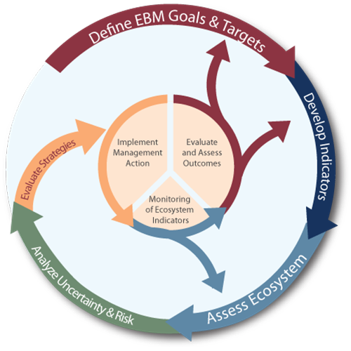 .footnote[ [1] https://www.integratedecosystemassessment.noaa.gov/national/IEA-approach ] ] ??? --- ## State of the Ecosystem: Maintain 2021 structure for 2022 .pull-left[ ## 2021 Report 1. Graphical summary + Page 1 report card re: objectives → + Page 2 risk summary bullets + Page 3 synthesis themes 1. Performance relative to management objectives 1. Risks to meeting management objectives ] .pull-right[ <table class="table" style="font-size: 14px; margin-left: auto; margin-right: auto;"> <caption style="font-size: initial !important;">Ecosystem-scale fishery management objectives</caption> <thead> <tr> <th style="text-align:left;font-weight: bold;"> Objective Categories </th> <th style="text-align:left;font-weight: bold;"> Indicators reported here </th> </tr> </thead> <tbody> <tr grouplength="6"><td colspan="2" style="border-bottom: 1px solid;"><strong>Provisioning and Cultural Services</strong></td></tr> <tr> <td style="text-align:left; padding-left: 2em;" indentlevel="1"> Seafood Production </td> <td style="text-align:left;"> Landings; commercial total and by feeding guild; recreational harvest </td> </tr> <tr> <td style="text-align:left; padding-left: 2em;" indentlevel="1"> Profits </td> <td style="text-align:left;"> Revenue decomposed to price and volume </td> </tr> <tr> <td style="text-align:left; padding-left: 2em;" indentlevel="1"> Recreation </td> <td style="text-align:left;"> Days fished; recreational fleet diversity </td> </tr> <tr> <td style="text-align:left; padding-left: 2em;" indentlevel="1"> Stability </td> <td style="text-align:left;"> Diversity indices (fishery and ecosystem) </td> </tr> <tr> <td style="text-align:left; padding-left: 2em;" indentlevel="1"> Social & Cultural </td> <td style="text-align:left;"> Community engagement/reliance status </td> </tr> <tr> <td style="text-align:left; padding-left: 2em;" indentlevel="1"> Protected Species </td> <td style="text-align:left;"> Bycatch; population (adult and juvenile) numbers, mortalities </td> </tr> <tr grouplength="4"><td colspan="2" style="border-bottom: 1px solid;"><strong>Supporting and Regulating Services</strong></td></tr> <tr> <td style="text-align:left; padding-left: 2em;" indentlevel="1"> Biomass </td> <td style="text-align:left;"> Biomass or abundance by feeding guild from surveys </td> </tr> <tr> <td style="text-align:left; padding-left: 2em;" indentlevel="1"> Productivity </td> <td style="text-align:left;"> Condition and recruitment of managed species, Primary productivity </td> </tr> <tr> <td style="text-align:left; padding-left: 2em;" indentlevel="1"> Trophic structure </td> <td style="text-align:left;"> Relative biomass of feeding guilds, Zooplankton </td> </tr> <tr> <td style="text-align:left; padding-left: 2em;" indentlevel="1"> Habitat </td> <td style="text-align:left;"> Estuarine and offshore habitat conditions </td> </tr> </tbody> </table> ] --- ## State of the Ecosystem summary: Retain for 2022 and update where possible .pull-left[ .center[ 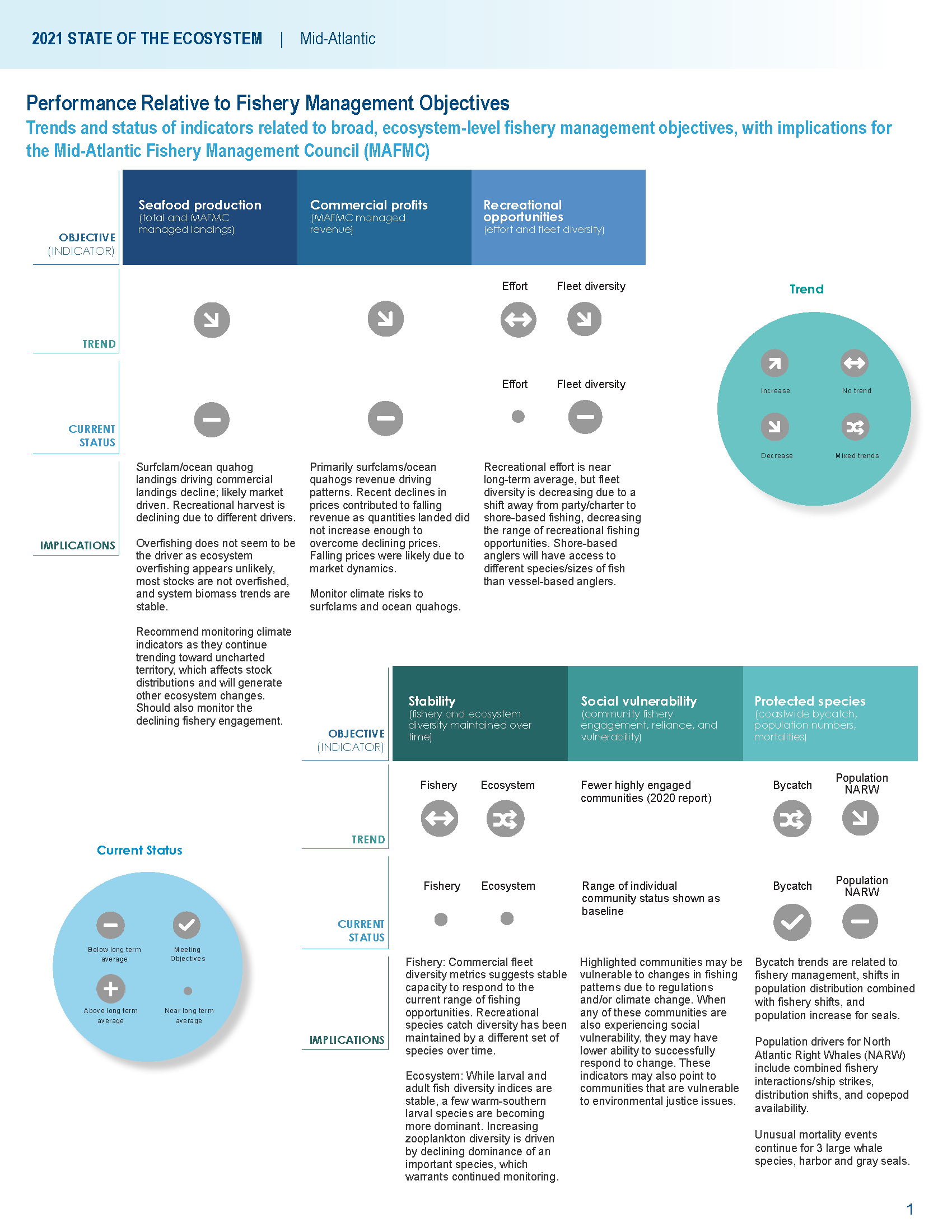 ] ] .pull-right[ .center[ 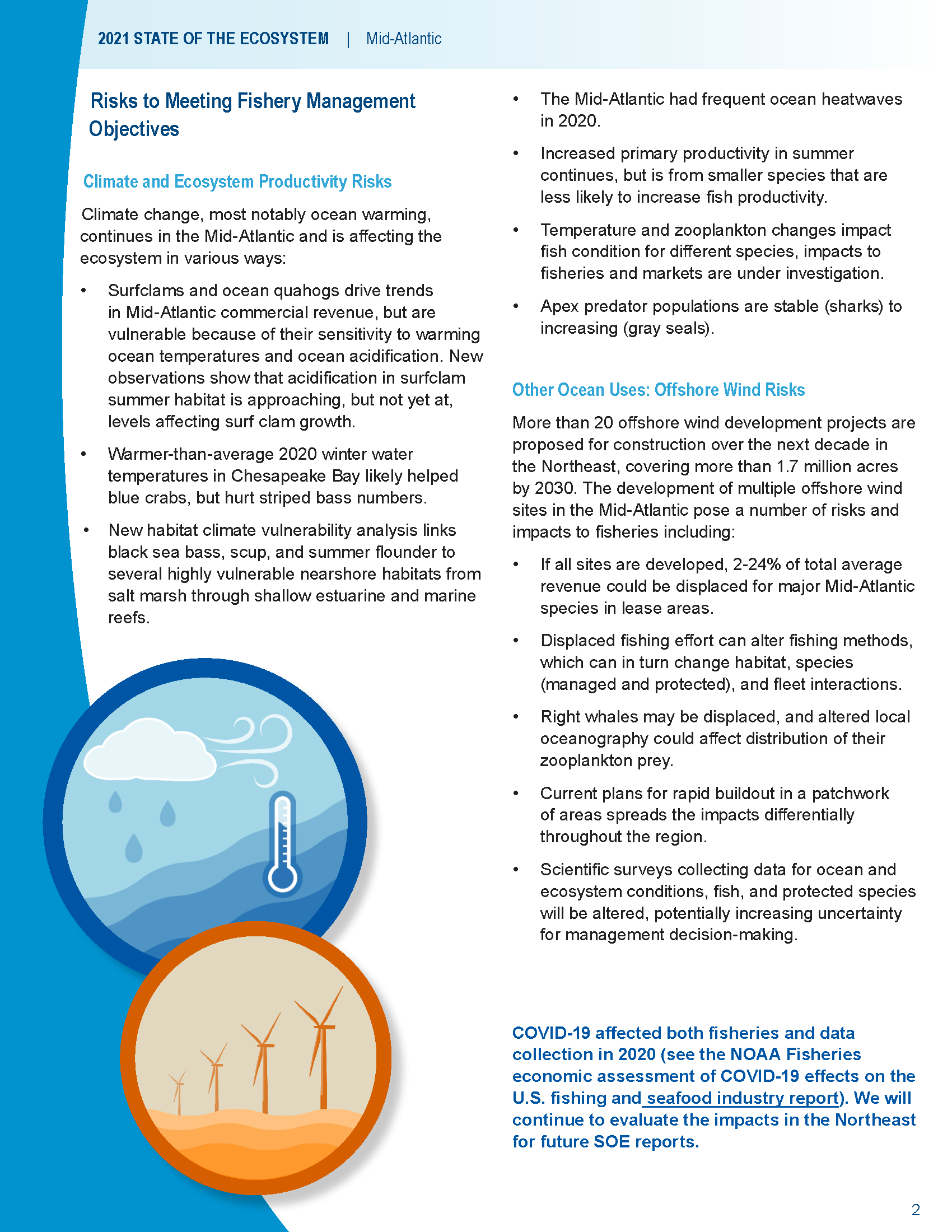 ] ] --- ## Ecosystem synthesis themes: emphasize throughout document Characterizing ecosystem change for fishery management * Societal, biological, physical and chemical factors comprise the **multiple system drivers** that influence marine ecosystems through a variety of different pathways. * Changes in the multiple drivers can lead to **regime shifts** — large, abrupt and persistent changes in the structure and function of an ecosystem. * Regime shifts and changes in how the multiple system drivers interact can result in **ecosystem reorganization** as species and humans respond and adapt to the new environment. .pull-left[ 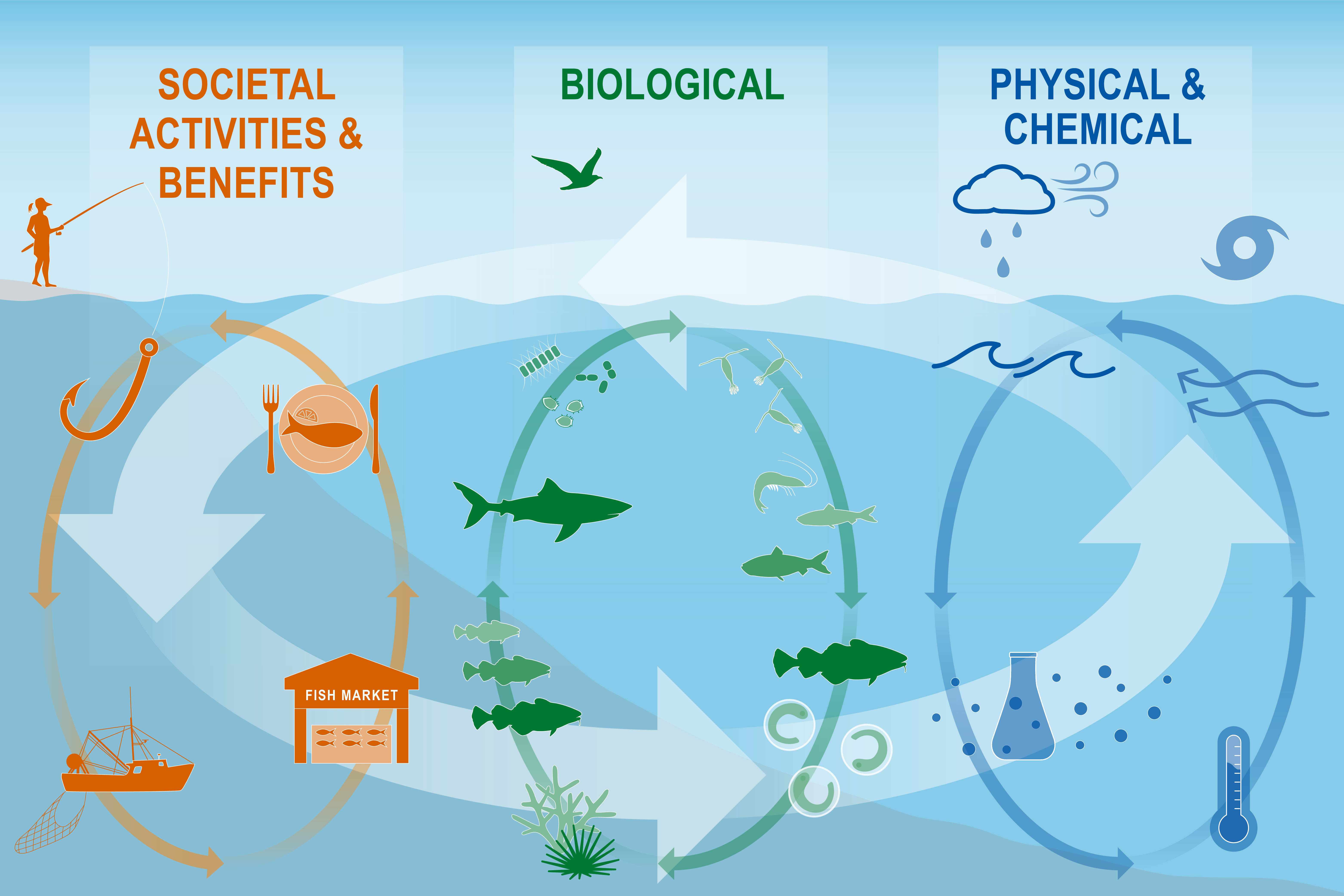 ] .pull-right[ 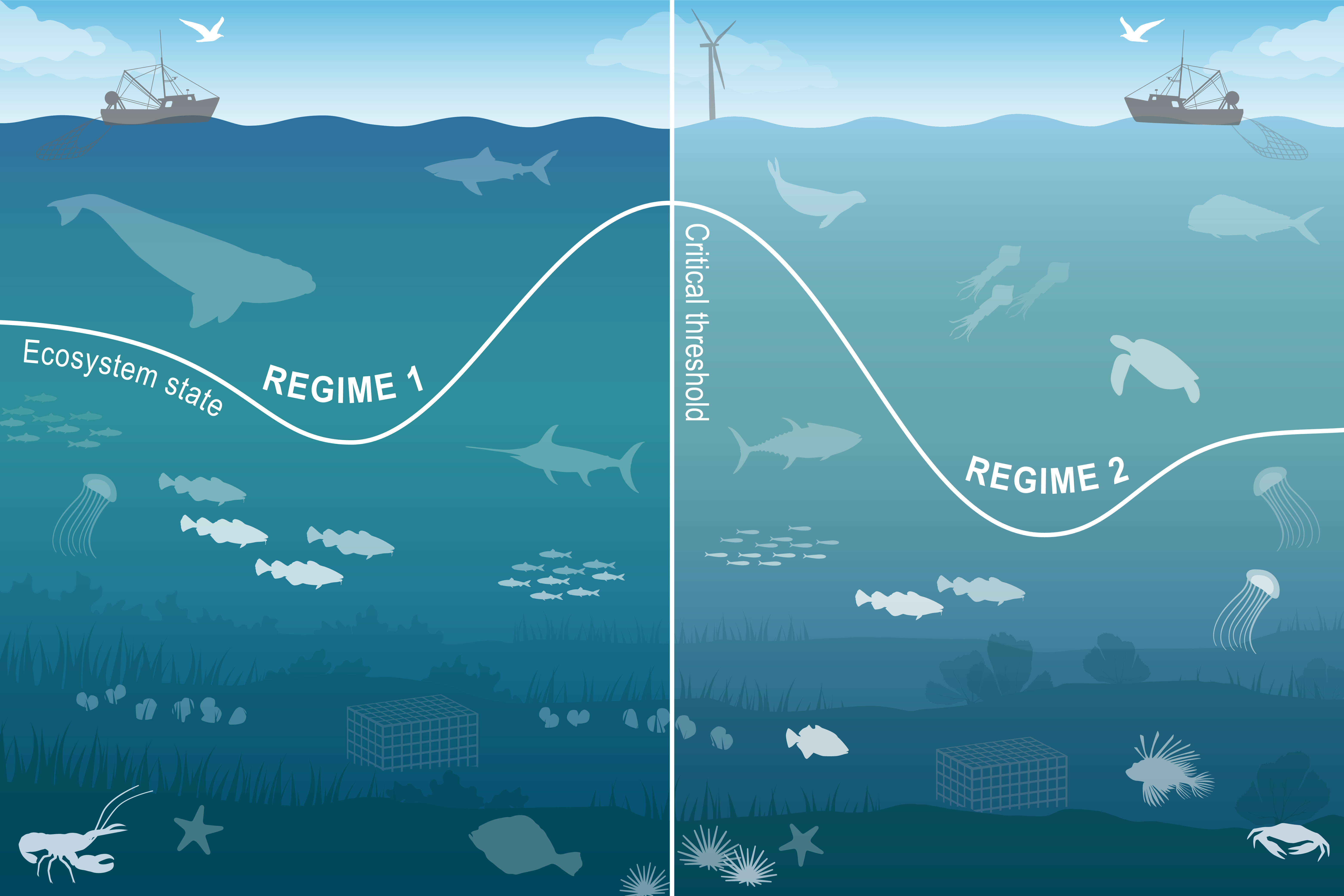 ] --- ## Document Orientation .pull-left[ Spatial scale 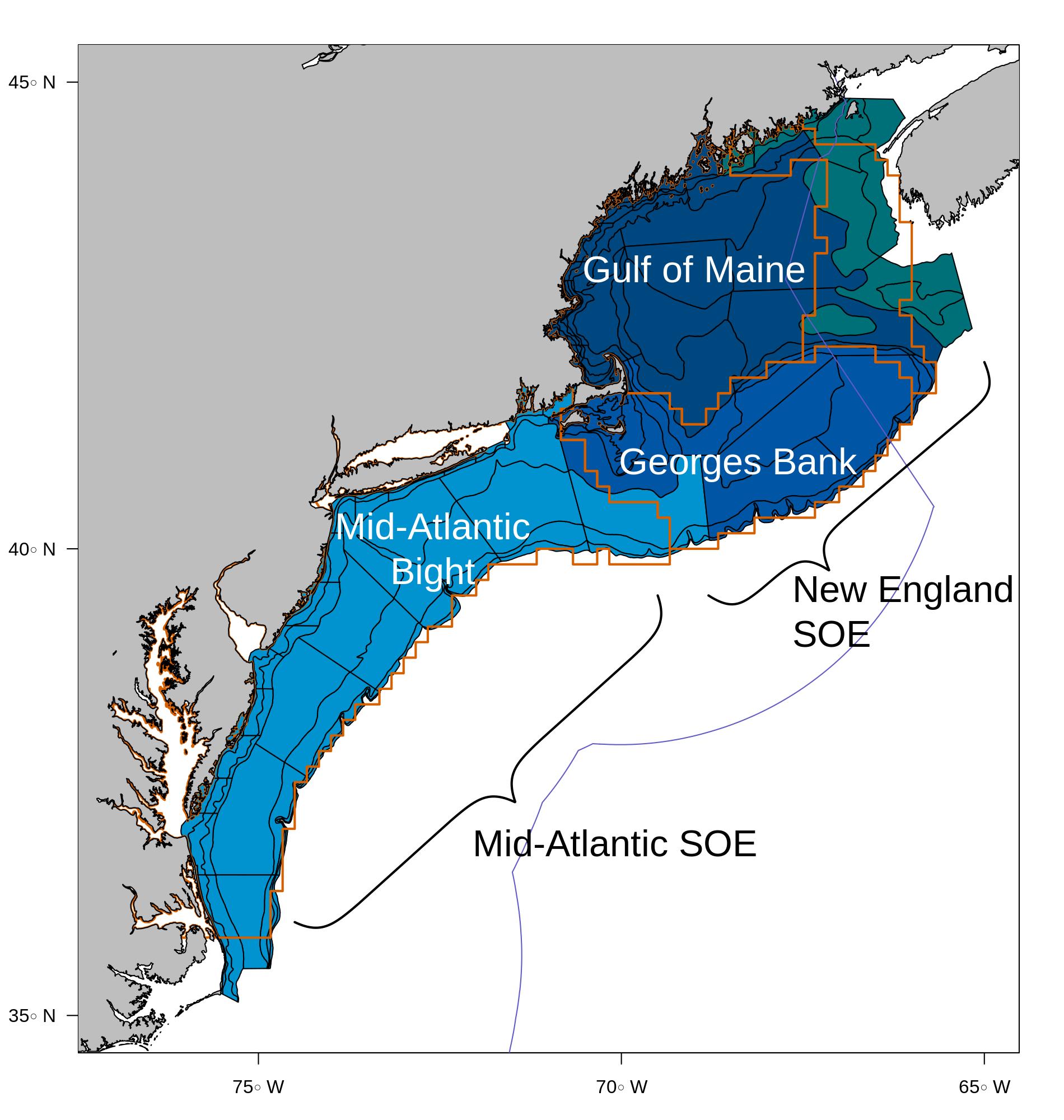 A [glossary of terms](https://noaa-edab.github.io/tech-doc/glossary.html) (2021 Memo 5), detailed [technical methods documentation](https://NOAA-EDAB.github.io/tech-doc) and [indicator data](https://github.com/NOAA-EDAB/ecodata) are available online. ] .pull-right[ Key to figures <img src="20220118_Plenary1_Gaichas_files/figure-html/unnamed-chunk-5-1.png" width="396" style="display: block; margin: auto;" /> .contrib[ Trends assessed only for 30+ years: [more information](https://noaa-edab.github.io/tech-doc/trend-analysis.html) <p style="color:#FF8C00;">Orange line = significant increase</p> <p style="color:#9932CC;">Purple line = significant decrease</p> No color line = not significant or < 30 years <p style="background-color:#D3D3D3;">Grey background = last 10 years</p> ] ] --- ## 2021: Revised structure to address Council requests and improve synthesis .pull-left[ * Performance relative to management objectives - *What* does the indicator say--up, down, stable? - *Why* do we think it is changing: integrates synthesis themes - Multiple drivers - Regime shifts - Ecosystem reorganization * Objectives - Seafood production - Profits - Recreational opportunities - Stability - Social and cultural - Protected species ] .pull-right[ * Risks to meeting fishery management objectives - *What* does the indicator say--up, down, stable? - *Why* this is important to managers: integrates synthesis themes - Multiple drivers - Regime shifts - Ecosystem reorganization * Risk categories - Climate: warming, ocean currents, acidification - Habitat changes (incl. vulnerability analysis) - Productivity changes (system and fish) - Species interaction changes - Community structure changes - Other ocean uses - Offshore wind development ] --- # Performance relative to management objectives .center[ 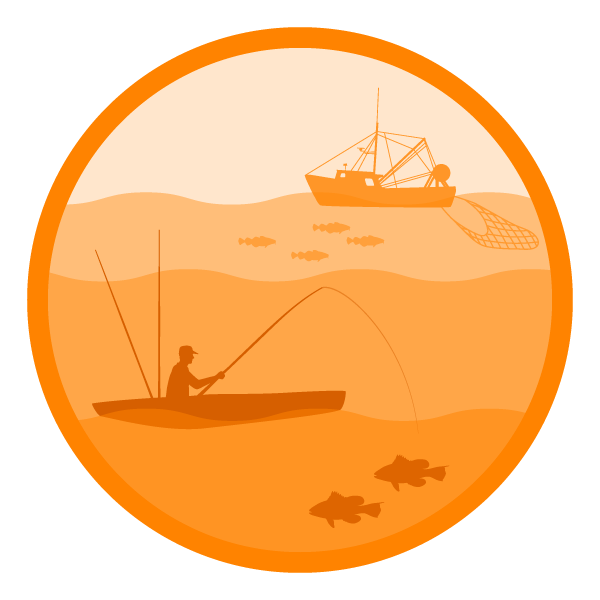 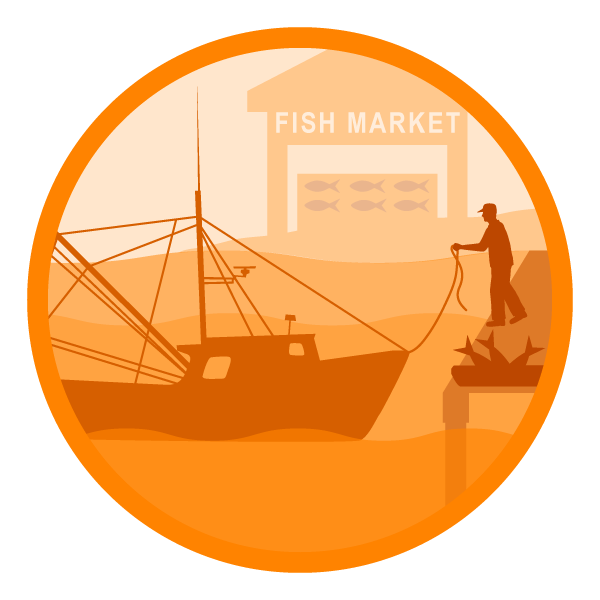 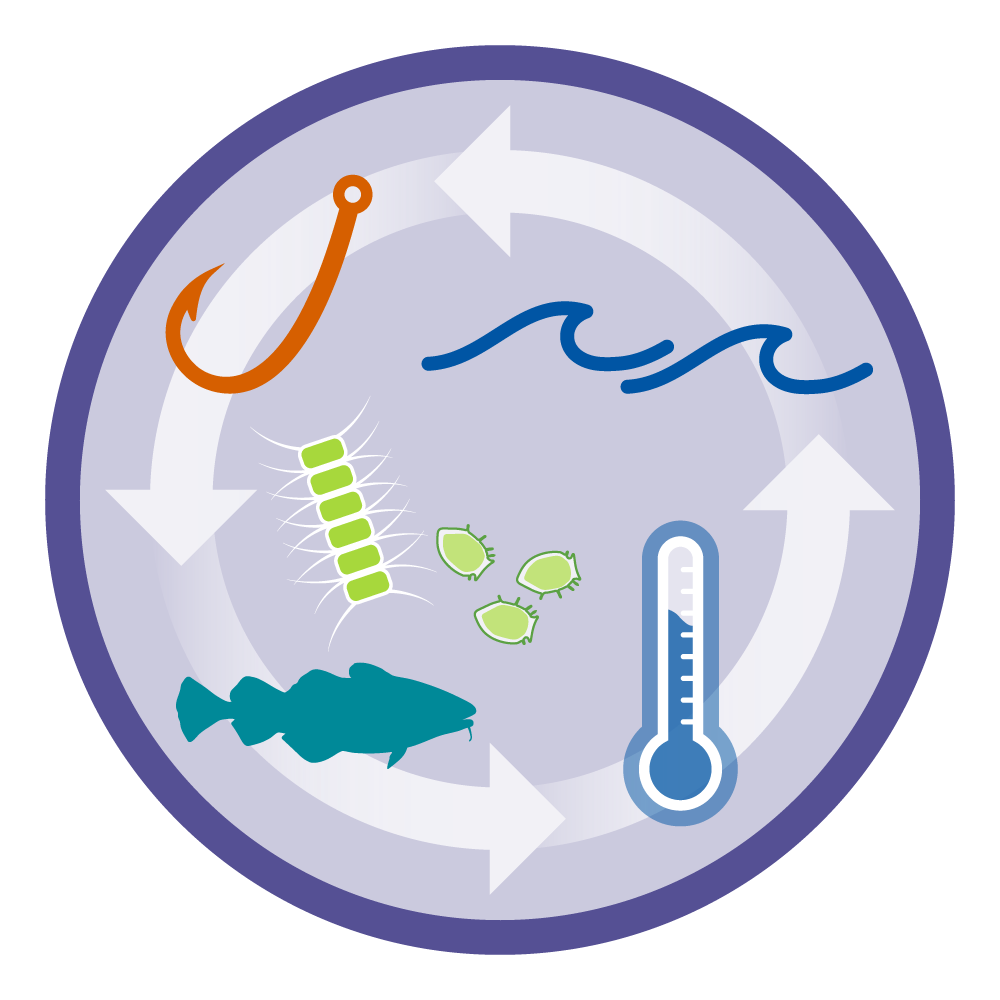 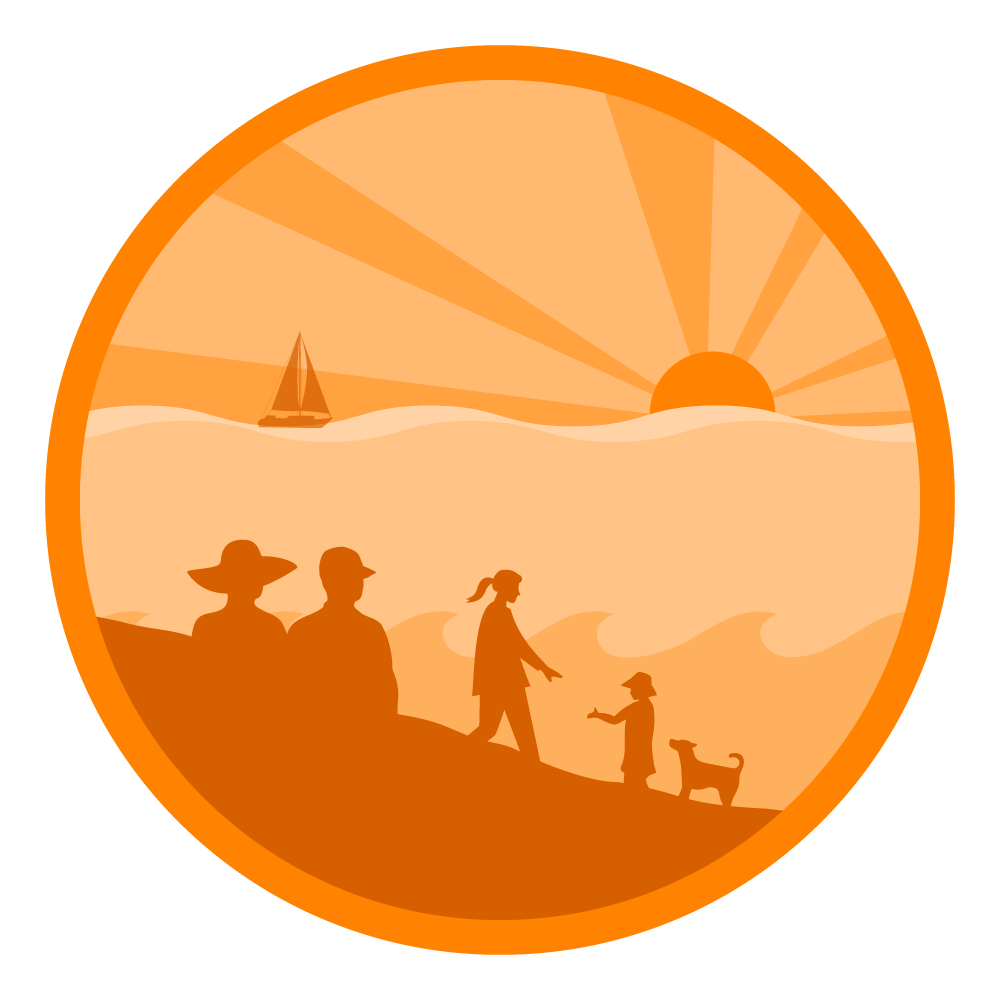 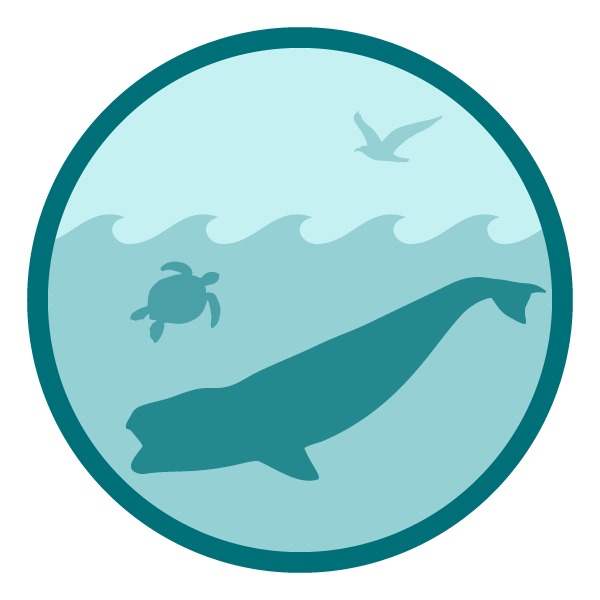 ] --- ## Objective: Seafood production   <!--  Risk elements: <span style="background-color:red;">ComFood</span> and <span style="background-color:orange;">RecFood</span>, unchanged--> .pull-left[ Indicators: Commercial and recreational landings .reduced_opacity[ <img src="20220118_Plenary1_Gaichas_files/figure-html/unnamed-chunk-6-1.png" width="504" style="display: block; margin: auto;" /> .contrib[ Key: Black = Landings of all species combined; <p style="color:#FF6A6A;">Red = Landings of MAFMC managed species</p> ] ] <img src="20220118_Plenary1_Gaichas_files/figure-html/unnamed-chunk-7-1.png" width="504" style="display: block; margin: auto;" /> ] .pull-right[ Multiple drivers: ecosystem and stock production, management, market conditions, and environment Is biomass driving? <img src="20220118_Plenary1_Gaichas_files/figure-html/unnamed-chunk-8-1.png" width="576" style="display: block; margin: auto;" /> .contrib[ Key: Black = NEFSC survey; <p style="color:#FF6A6A;">Red = NEAMAP survey</p> ] ] --- ## Landings drivers: Ecosystem or stock production? <!--   Risk elements: Fstatus, Bstatus mostly unchanged--> .pull-left[ .reduced_opacity[ <img src="20220118_Plenary1_Gaichas_files/figure-html/unnamed-chunk-9-1.png" width="504" style="display: block; margin: auto;" /> <img src="20220118_Plenary1_Gaichas_files/figure-html/unnamed-chunk-10-1.png" width="504" style="display: block; margin: auto;" /> .contrib[ Key: <span style="background-color:#f4a460;">Orange background = Tipping point overfishing threshold, Link and Watson 2019</span> <span style="background-color:#a2cd5a;">Green background = Optimal range, Link and Watson 2019</span> ] ] ] .pull-right[ .reduced_opacity[ <img src="20220118_Plenary1_Gaichas_files/figure-html/unnamed-chunk-11-1.png" width="504" style="display: block; margin: auto;" /> ] <img src="20220118_Plenary1_Gaichas_files/figure-html/unnamed-chunk-12-1.png" width="540" style="display: block; margin: auto;" /> ] --- ## Implications: Seafood Production .pull-left[ .reduced_opacity[ <img src="20220118_Plenary1_Gaichas_files/figure-html/unnamed-chunk-15-1.png" width="360" style="display: block; margin: auto;" /> .contrib[ Key: Black = Landings of all species combined; <p style="color:#FF6A6A;">Red = Landings of MAFMC managed species</p> ] ] ] .pull-right[ Drivers: .reduced_opacity[ * market dynamics affecting commercial landings of surfclams and ocean quahogs ] * other drivers affecting recreational landings: shark fishery management, possibly survey methodology <img src="20220118_Plenary1_Gaichas_files/figure-html/unnamed-chunk-16-1.png" width="360" style="display: block; margin: auto;" /> Monitor: * climate risks including warming, ocean acidification, and shifting distributions * ecosystem composition and production changes * fishing engagement ] ??? Because ecosystem overfishing seems unlikely, stock status is mostly acceptable, and aggregate biomass trends appear stable, the decline in commercial landings is most likely driven by market dynamics affecting the landings of surfclams and ocean quahogs, as quotas are not binding for these species. Climate change also seems to be shifting the distribution of surfclams and ocean quahogs, resulting in areas with overlapping distributions and increased mixed landings. Given the regulations governing mixed landings, this could become problematic in the future and is currently being evaluated by the Council. --- ## Objective: Commercial Profits   <!--  Risk element: <span style="background-color:orange;">CommRev</span>, unchanged--> .pull-left[ Indicator: Commercial Revenue .reduced_opacity[ <img src="20220118_Plenary1_Gaichas_files/figure-html/unnamed-chunk-17-1.png" width="360" style="display: block; margin: auto;" /> .contrib[ Key: Black = Revenue of all species combined; <p style="color:#FF6A6A;">Red = Revenue of MAFMC managed species</p> ] Recent change driven by benthos ] Monitor changes in climate and landings drivers: <!-- - Climate risk element: <span style="background-color:orange;">Surfclams</span> and <span style="background-color:red;">ocean quahogs</span> are sensitive to ocean warming and acidification. --> - Surfclams and ocean quahogs are sensitive to ocean warming and acidification. - pH in surfclam summer habitat is approaching, but not yet at, pH affecting surfclam growth ] .pull-right[ Indicator: Bennet--price and volume indices .reduced_opacity[ <img src="20220118_Plenary1_Gaichas_files/figure-html/unnamed-chunk-18-1.png" width="504" style="display: block; margin: auto;" /> <img src="20220118_Plenary1_Gaichas_files/figure-html/unnamed-chunk-19-1.png" width="540" style="display: block; margin: auto;" /> ] ] ??? Recent declines in prices contributed to falling revenue as quantities landed did not increase enough to counteract declining prices. --- ## Multiple drivers of landings, revenue, recreation: new indicator Indicator: Realized catch relative to management target (ABC or ACL) .pull-left[ <img src="20220118_Plenary1_Gaichas_files/figure-html/unnamed-chunk-20-1.png" width="504" style="display: block; margin: auto;" /> ] .pull-right[ Implications ] --- ## Objective: Recreational opportunities  ;   <!--  Risk element: <span style="background-color:red;">RecValue</span>, unchanged; add diversity?--> .pull-left[ Indicators: Recreational effort and fleet diversity <img src="20220118_Plenary1_Gaichas_files/figure-html/unnamed-chunk-21-1.png" width="504" style="display: block; margin: auto;" /> <img src="20220118_Plenary1_Gaichas_files/figure-html/unnamed-chunk-22-1.png" width="504" style="display: block; margin: auto;" /> ] .pull-right[ Implications * Recreational effort ... * Decline in recreational fleet diversity suggests a potentially reduced range of opportunities. * Driven by party/charter contraction (from a high of 24% of angler trips to 7% currently), and a shift toward shore based angling. * Absence of a long-term trend in recreational effort suggests relative stability in the overall number of recreational opportunities in the MAB. * 2021 Memo 22-23, Cumulative weather index and management complexity drivers under construction ] ??? Changes in recreational fleet diversity can be considered when managers seek options to maintain recreational opportunities. Shore anglers will have access to different species than vessel-based anglers, and when the same species, typically smaller fish. Many states have developed shore-based regulations where the minimum size is lower than in other areas and sectors to maintain opportunities in the shore angling sector. --- ## Objective: Stability   <!--  Risk elements: <span style="background-color:lightgreen;">FishRes1</span> and <span style="background-color:lightgreen;">FleetDiv</span>, unchanged, add recreational elements? --> .pull-left[ *Fishery* Indicators: Commercial fleet count, fleet diversity <img src="20220118_Plenary1_Gaichas_files/figure-html/unnamed-chunk-23-1.png" width="504" style="display: block; margin: auto;" /> ] .pull-right[ *Fishery* Indicators: commercial species revenue diversity, recreational species catch diversity <img src="20220118_Plenary1_Gaichas_files/figure-html/unnamed-chunk-24-1.png" width="504" style="display: block; margin: auto;" /> <img src="20220118_Plenary1_Gaichas_files/figure-html/unnamed-chunk-25-1.png" width="504" style="display: block; margin: auto;" /> ] --- ## Objective: Stability   <!--  Risk element: ecological diversity put aside, new indices--> .pull-left[ *Ecological* Indicators: zooplankton and larval fish diversity .reduced_opacity[ <img src="20220118_Plenary1_Gaichas_files/figure-html/unnamed-chunk-26-1.png" width="504" style="display: block; margin: auto;" /> <img src="20220118_Plenary1_Gaichas_files/figure-html/unnamed-chunk-27-1.png" width="504" style="display: block; margin: auto;" /> ] ] .pull-right[ *Ecological* Indicator: expected number of species, NEFSC bottom trawl survey <img src="20220118_Plenary1_Gaichas_files/figure-html/unnamed-chunk-28-1.png" width="504" style="display: block; margin: auto;" /> Implications: * stable capacity to respond to the current range of commercial fishing opportunities * recreational catch diversity maintained by a different set of species over time * monitor zooplankton diversity driven by declining dominant species ] ??? While larval and adult fish diversity indices are stable, a few warm-southern larval species are becoming more dominant. Increasing zooplankton diversity is driven by declining dominance of an important species, which warrants continued monitoring. --- ## Objective: Commercial fishing community status, environmental justice <!--  Risk element: <span style="background-color:yellow;">Social</span>, unchanged; new community level info--> Indicators: Social vulnerability, fishery engagement and reliance .pull-left[ <img src="20220118_Plenary1_Gaichas_files/figure-html/unnamed-chunk-29-1.png" width="468" style="display: block; margin: auto;" /> Mid-Atlantic commercial fishing communities ] .pull-right[ 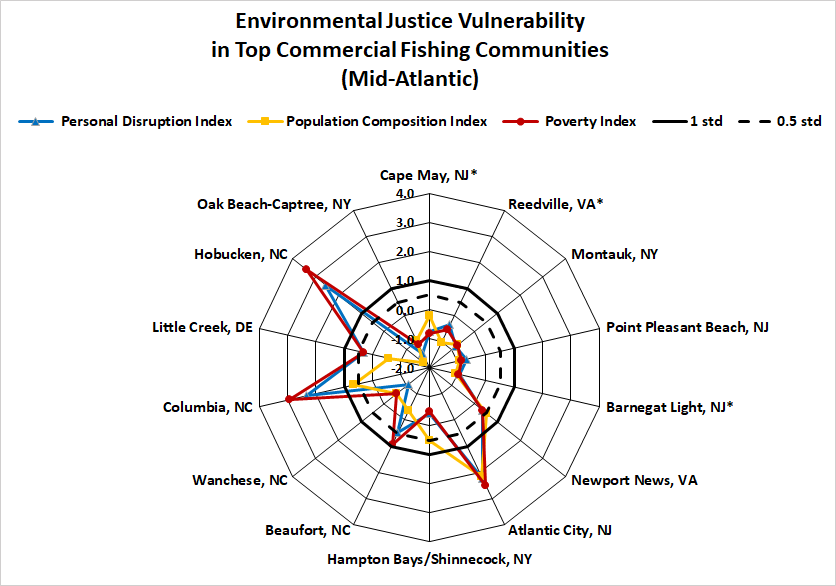 ] Implications: Highlighted communities may be vulnerable to changes in fishing patterns due to regulations and/or climate change. When any of these communities are also experiencing social vulnerability, they may have lower ability to successfully respond to change. These indicators may also point to communities that are vulnerable to environmental justice issues. --- ## Objective: Recreational fishing community status, environmental justice <!--  Risk element: <span style="background-color:yellow;">Social</span>, unchanged; new community level info--> Indicators: Social vulnerability, fishery engagement and reliance .pull-left[ <img src="20220118_Plenary1_Gaichas_files/figure-html/unnamed-chunk-30-1.png" width="468" style="display: block; margin: auto;" /> Mid-Atlantic recreational fishing communities ] .pull-right[ 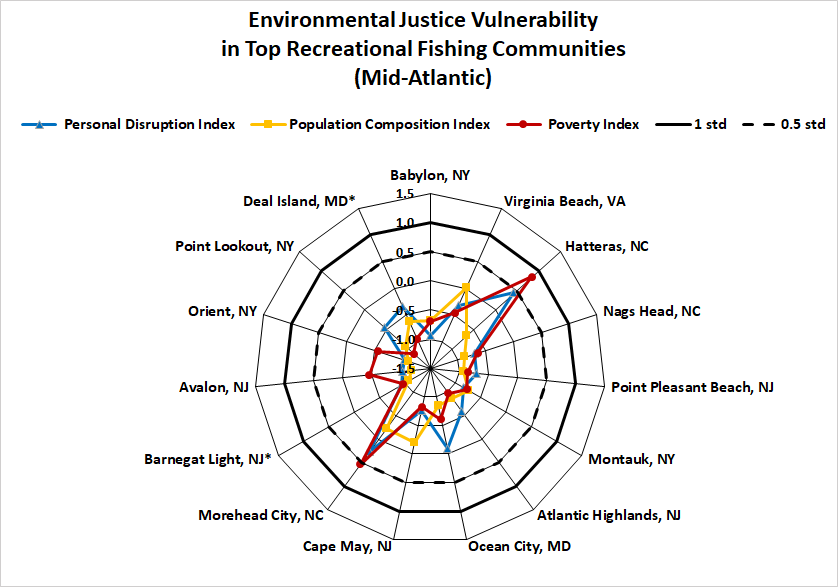 ] Implications: Highlighted communities may be vulnerable to changes in fishing patterns due to regulations and/or climate change. When any of these communities are also experiencing social vulnerability, they may have lower ability to successfully respond to change. These indicators may also point to communities that are vulnerable to environmental justice issues. --- ## Objectives: Protected species *Maintain bycatch below thresholds*   .pull-left[ Indicators: Harbor porpoise and gray seal bycatch .reduced_opacity[ <img src="20220118_Plenary1_Gaichas_files/figure-html/unnamed-chunk-31-1.png" width="504" style="display: block; margin: auto;" /> <img src="20220118_Plenary1_Gaichas_files/figure-html/unnamed-chunk-32-1.png" width="504" style="display: block; margin: auto;" /> ] ] .pull-right[ Implications: * Currently meeting objectives <!--* Risk element: TechInteract, evaluated by species and sector: 14 <span style="background-color:lightgreen;">low</span>, 6 <span style="background-color:yellow;">low-mod</span>, 3 <span style="background-color:orange;">mod-high</span> risk, unchanged--> * The downward trend in harbor porpoise bycatch can also be due to a decrease in harbor porpoise abundance in US waters, reducing their overlap with fisheries, and a decrease in gillnet effort. * The increasing trend in gray seal bycatch may be related to an increase in the gray seal population (U.S. pup counts). ] --- ## Objectives: Protected species *Recover endangered populations*   .pull-left[ Indicators: North Atlantic right whale population, calf counts <img src="20220118_Plenary1_Gaichas_files/figure-html/unnamed-chunk-33-1.png" width="504" style="display: block; margin: auto;" /> <img src="20220118_Plenary1_Gaichas_files/figure-html/unnamed-chunk-34-1.png" width="504" style="display: block; margin: auto;" /> ] .pull-right[ Implications: * Population drivers for North Atlantic Right Whales (NARW) include combined fishery interactions/ship strikes, distribution shifts, and copepod availability. * Unusual mortality events continue for 3 large whale species, harbor and gray seals. <!--* Risk elements: - FW2Prey evaluated by species: 13 <span style="background-color:lightgreen;">low</span>, 3 <span style="background-color:yellow;">low-mod</span> risk, unchanged - TechInteract, evaluated by species and sector, unchanged--> ] --- # Risks to meeting fishery management objectives .center[ 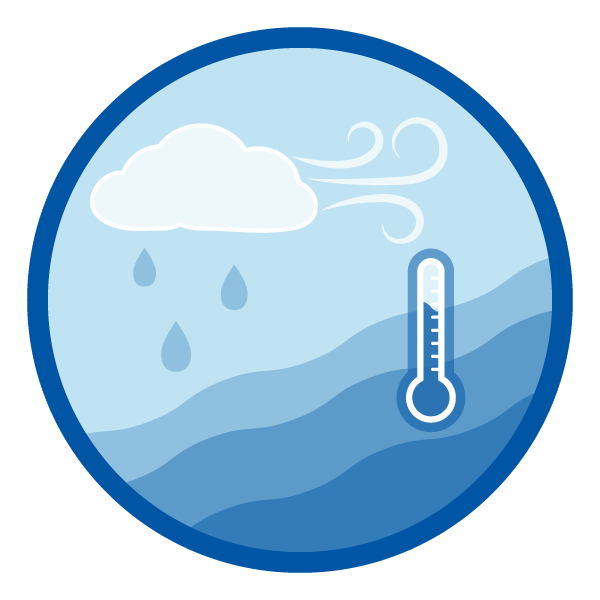 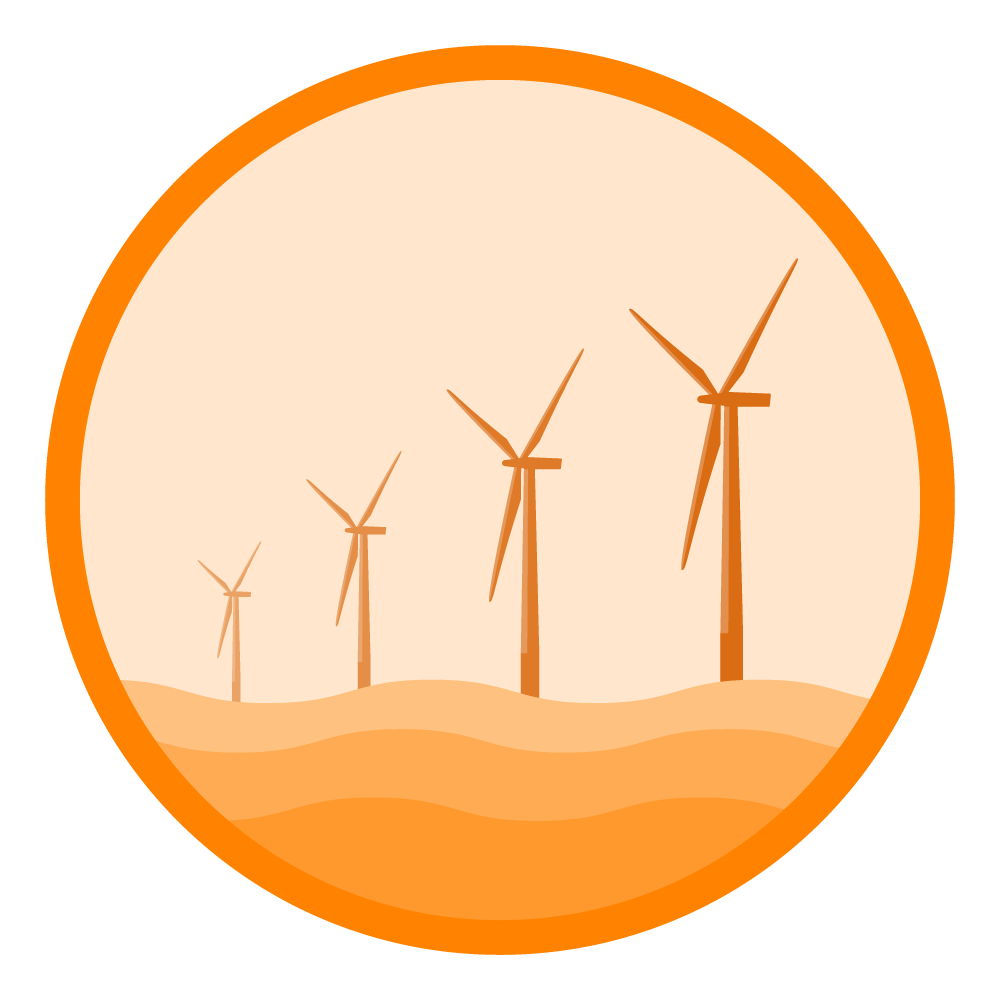 ] .center[ 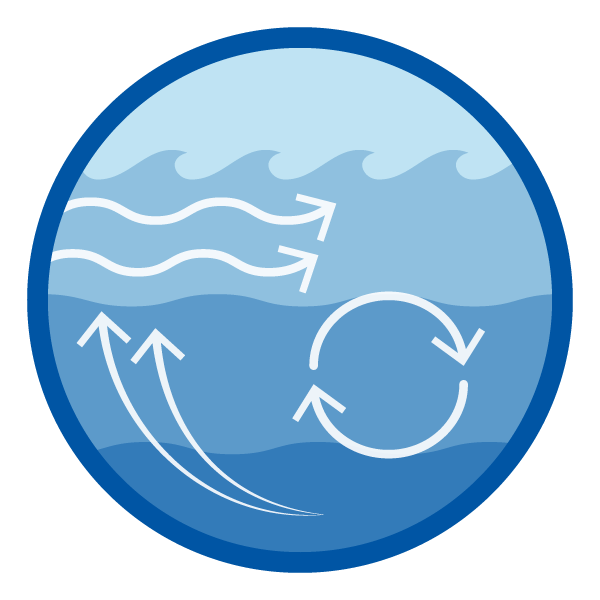 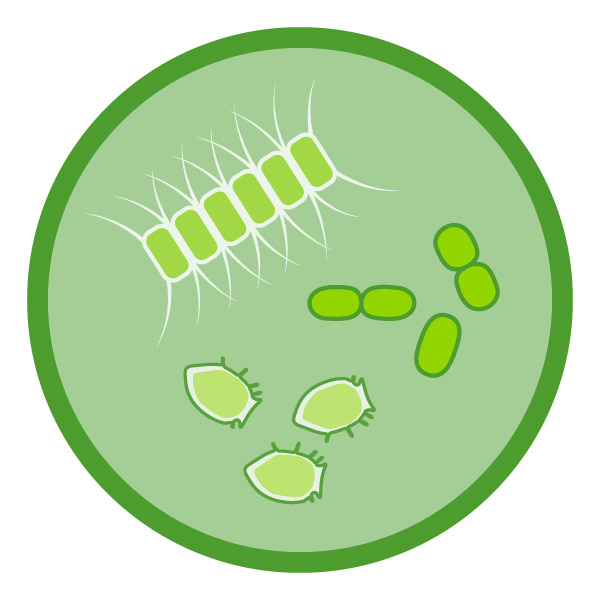 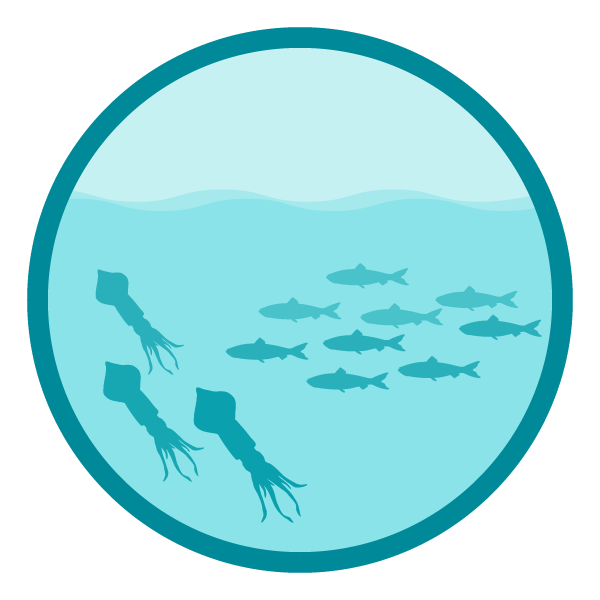 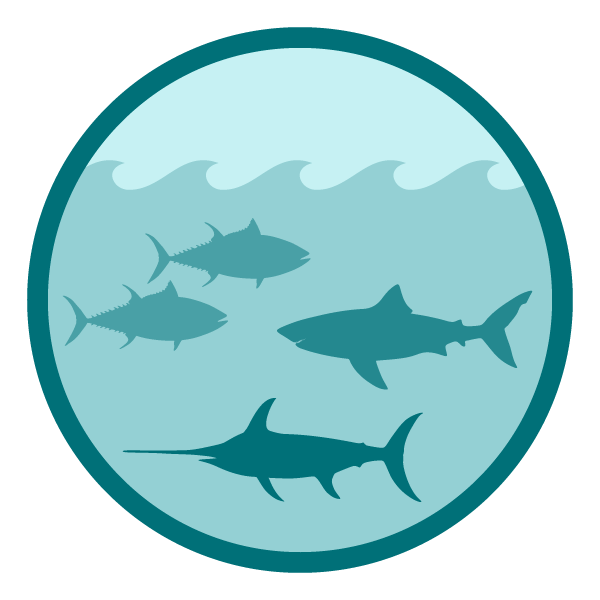 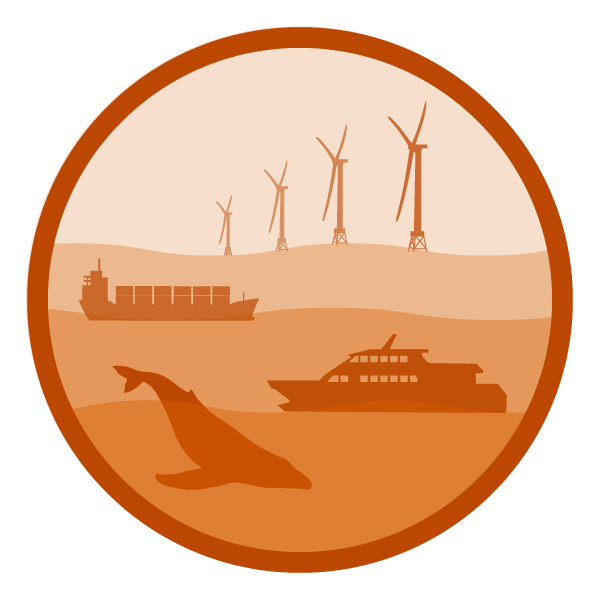 ] --- background-image: url("EDAB_images/seasonal-sst-anom-gridded-2021.png") background-size: 700px background-position: right top ## Risks: Climate change .pull-left[ Indicators: ocean currents, bottom and surface temperature, marine heatwaves <img src="20220118_Plenary1_Gaichas_files/figure-html/unnamed-chunk-35-1.png" width="288" style="display: block; margin: auto;" /> <img src="20220118_Plenary1_Gaichas_files/figure-html/unnamed-chunk-36-1.png" width="288" style="display: block; margin: auto;" /> <img src="20220118_Plenary1_Gaichas_files/figure-html/unnamed-chunk-37-1.png" width="504" style="display: block; margin: auto;" /> ] .pull-right[ <img src="20220118_Plenary1_Gaichas_files/figure-html/unnamed-chunk-38-1.png" width="360" style="display: block; margin: auto;" /> ] ??? A marine heatwave is a warming event that lasts for five or more days with sea surface temperatures above the 90th percentile of the historical daily climatology (1982-2011). --- ## Risks: Climate change and estuarine habitat <!--  Risk element: EstHabitat 10 <span style="background-color:lightgreen;">low</span>, 4 <span style="background-color:red;">high</span> risk species, unchanged, new indices--> Indicators: Estuarine conditions, Chesapeake Bay .pull-left[ 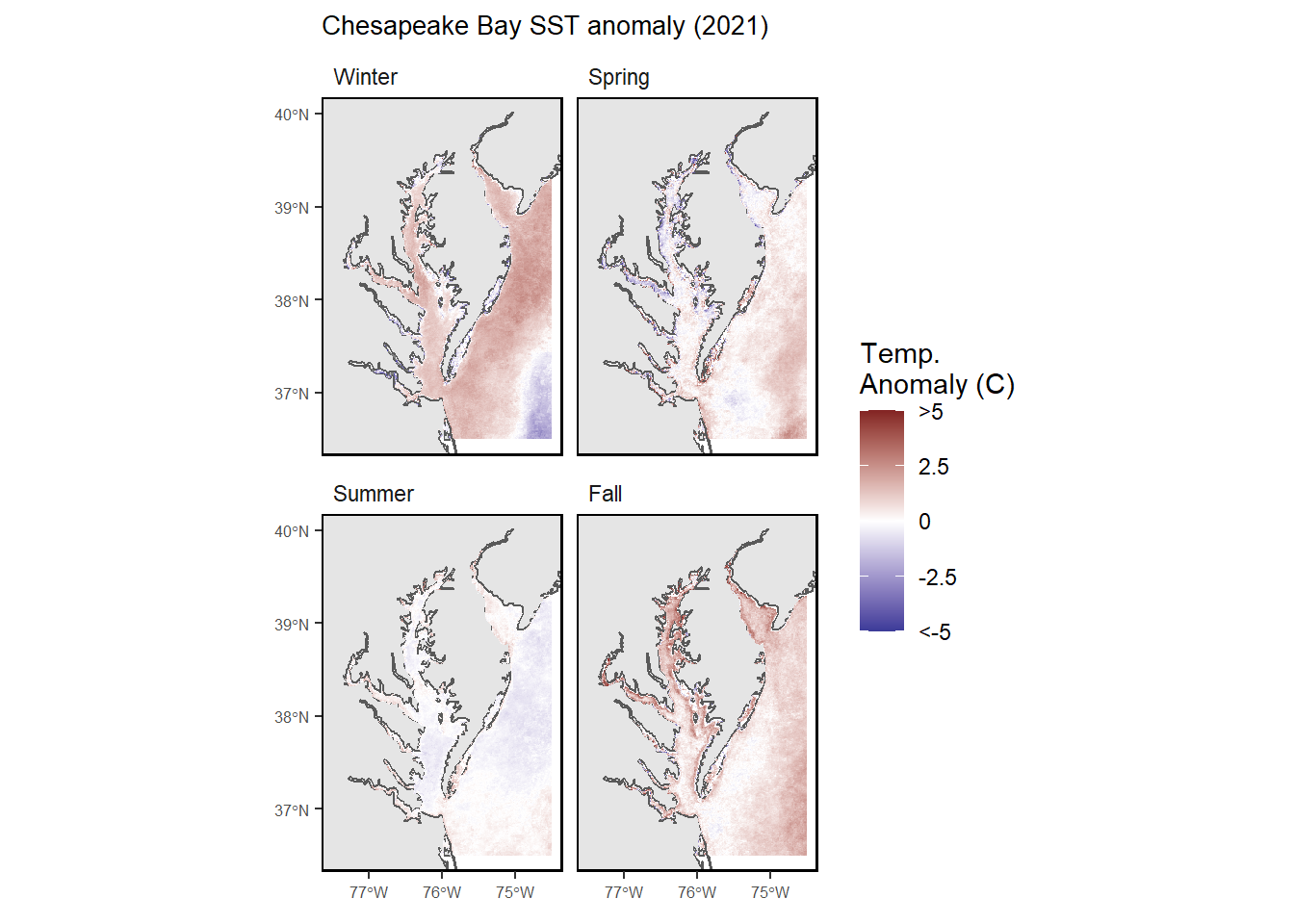 ] .pull-right[ <img src="20220118_Plenary1_Gaichas_files/figure-html/unnamed-chunk-39-1.png" width="504" style="display: block; margin: auto;" /> <img src="20220118_Plenary1_Gaichas_files/figure-html/unnamed-chunk-40-1.png" width="504" style="display: block; margin: auto;" /> ] --- ## Risks: Climate change and estuarine habitat Indicator: SAV trends in Chesapeake Bay .pull-left[ <img src="20220118_Plenary1_Gaichas_files/figure-html/unnamed-chunk-41-1.png" width="504" style="display: block; margin: auto;" /> ] .pull-right[ Indicator: Water quality attainment <img src="20220118_Plenary1_Gaichas_files/figure-html/unnamed-chunk-42-1.png" width="504" style="display: block; margin: auto;" /> ] Implications: *(synthesize with Chesapeake Bay summary a few slides from now)* --- ## Risks: Climate change and offshore habitat <!--   Risk element: offshore habitat put aside, new indices --> .pull-left[ Indicator: cold pool indices <img src="20220118_Plenary1_Gaichas_files/figure-html/unnamed-chunk-43-1.png" width="504" style="display: block; margin: auto;" /> Indicator: warm core rings <img src="20220118_Plenary1_Gaichas_files/figure-html/unnamed-chunk-44-1.png" width="504" style="display: block; margin: auto;" /> ] .pull-right[ Indicator: acidification 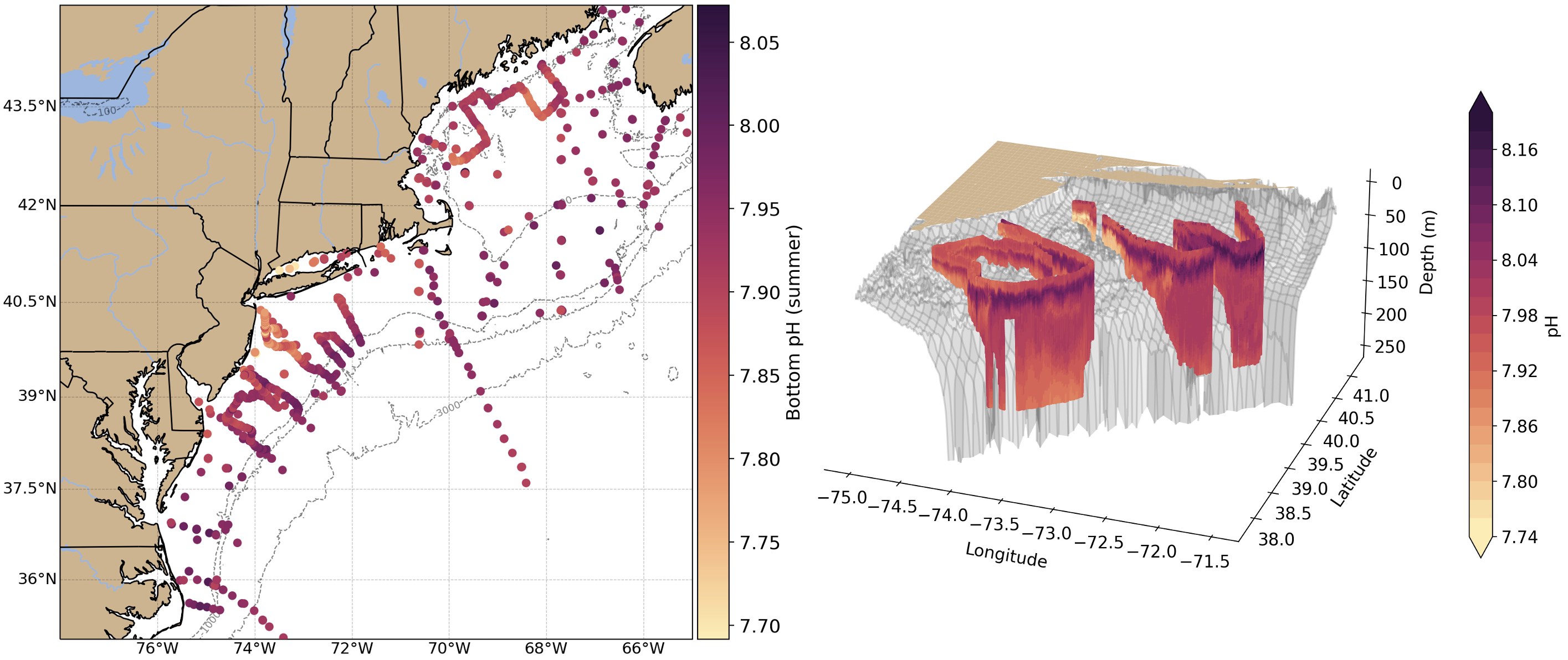 ] --- ## Risks: Ecosystem productivity <!--   Risk element: <span style="background-color:yellow;">EcoProd</span>, unchanged, new indices --> Indicators: primary production, zooplankton .pull-left[ <img src="20220118_Plenary1_Gaichas_files/figure-html/unnamed-chunk-45-1.png" width="576" style="display: block; margin: auto;" /> <img src="20220118_Plenary1_Gaichas_files/figure-html/unnamed-chunk-46-1.png" width="504" style="display: block; margin: auto;" /> ] .pull-right[ .reduced_opacity[ <img src="20220118_Plenary1_Gaichas_files/figure-html/unnamed-chunk-47-1.png" width="576" style="display: block; margin: auto;" /> <img src="20220118_Plenary1_Gaichas_files/figure-html/unnamed-chunk-48-1.png" width="504" style="display: block; margin: auto;" /> ] Implications: increased production by smaller phytoplankton implies less efficient transfer of primary production to higher trophic levels. Monitor implications of increasing gelatinous zooplankton and krill. ] ??? Increased temperatures, as reported above, can increase the rate of photosynthesis by phytoplankton (i.e. primary productivity). Annual primary production has increased over time, primarily driven by increased productivity in the summer months. Larger zooplankton (i.e. *Calanus finmarchicus*) had above average abundance in 2018-2019, while smaller-bodied copepods were near or below average. --- ## Risks: Ecosystem productivity <!--   Risk element: <span style="background-color:yellow;">EcoProd</span>, unchanged, new indices--> Indicators: plankton-based forage anomaly and forage fish energy content (2021 Memo 17) .pull-left-30[ .reduced_opacity[ <img src="20220118_Plenary1_Gaichas_files/figure-html/unnamed-chunk-49-1.png" width="504" style="display: block; margin: auto;" /> ] ] .pull-right-70[ <img src="20220118_Plenary1_Gaichas_files/figure-html/unnamed-chunk-50-1.png" width="576" style="display: block; margin: auto;" /> ] Implications: fluctuating environmental conditions and prey for forage species affect both abundance and energy content. Energy content varies by season, and has changed over time most dramatically for Atlantic herring --- ## Risks: Ecosystem productivity <!--   Risk element: <span style="background-color:yellow;">EcoProd</span>, unchanged, new analyses --> Indicators: fish condition (2021 Memo 18) .pull-left[ 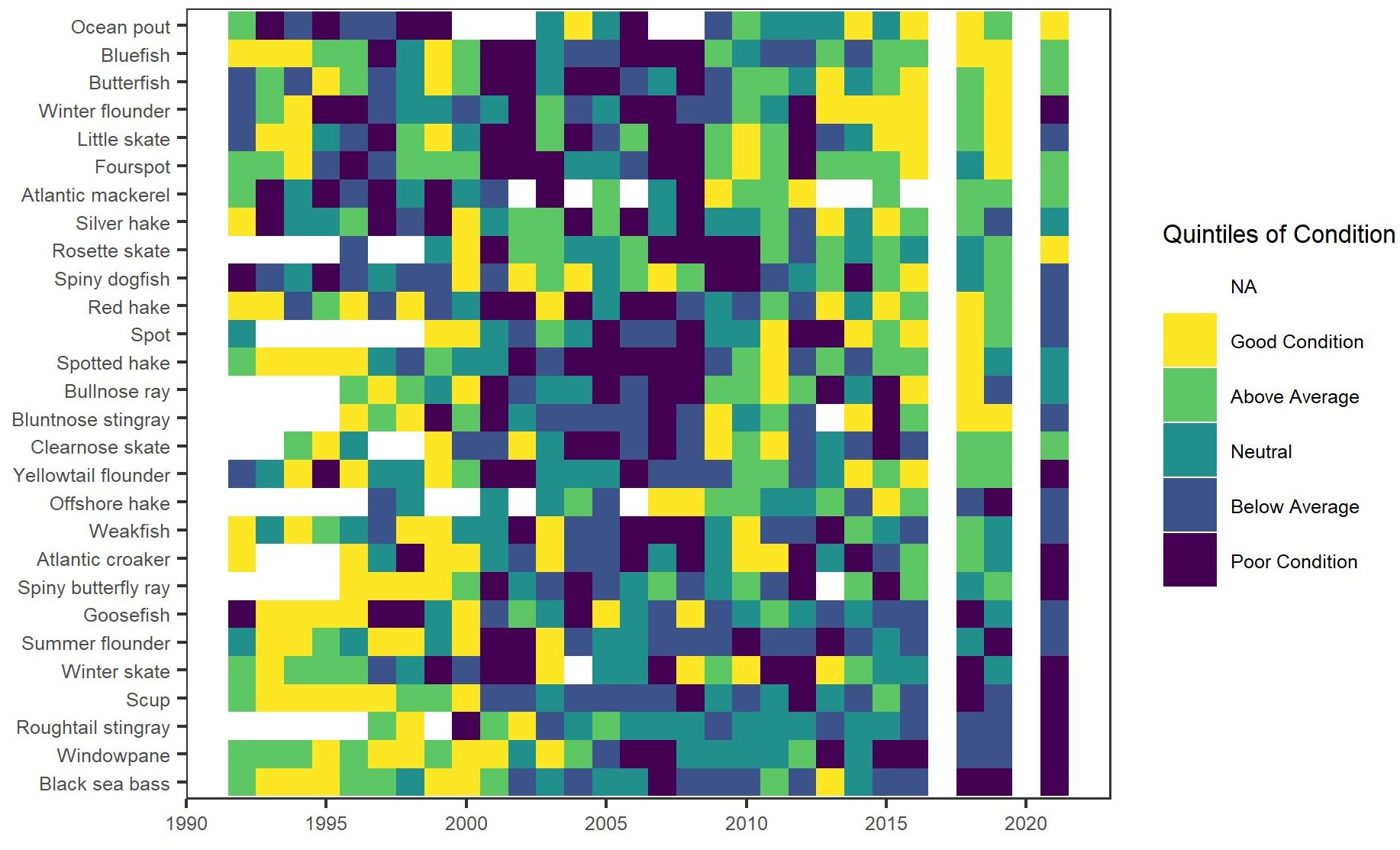 Preliminary results (2021): * Multiple, different condition drivers by species * Acadian redfish, butterfish and winter flounder more affected by fishing pressure and stock size * Weakfish, windowpane flounder, and American plaice more affected by local bottom temperatures and zooplankton ] .pull-right[ Indicator: fish productivity anomaly <img src="20220118_Plenary1_Gaichas_files/figure-html/unnamed-chunk-51-1.png" width="504" style="display: block; margin: auto;" /> <!--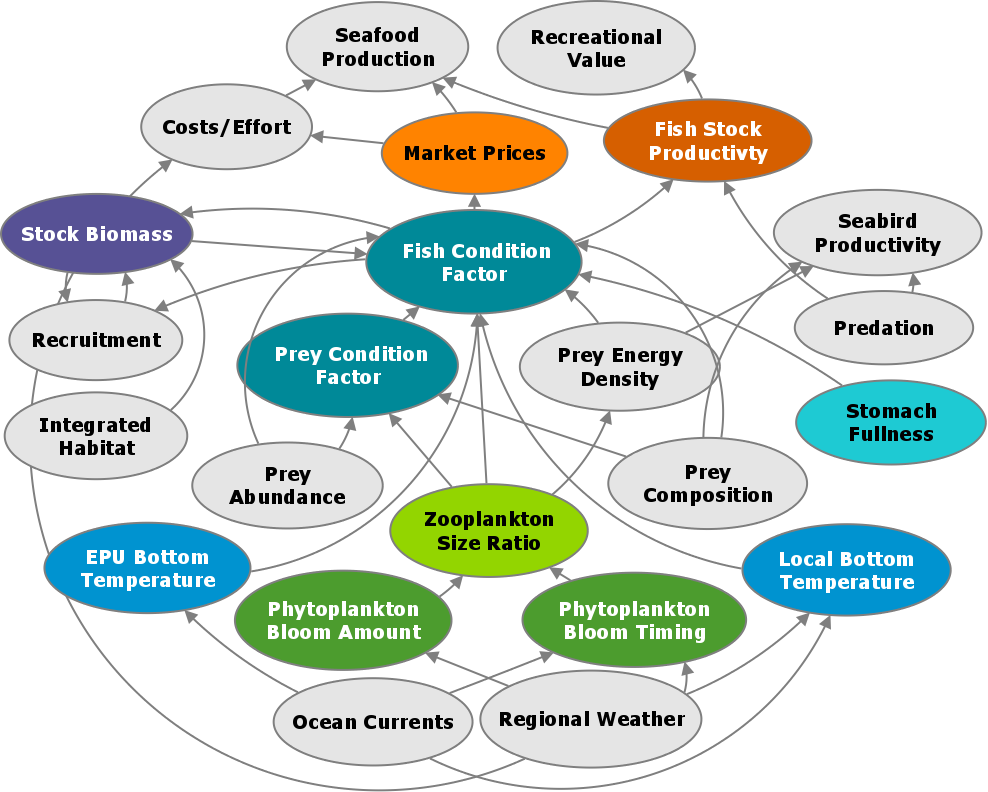--> ] Implications: ??? See memo for preliminary results These relationships can potentially provide insights on which species may be more vulnerable to environmental changes such as climate change, as well as what biomass changes may be expected from certain species given current environmental conditions --- ## Risks: Ecosystem structure <!--  Risk element: DistShift, unchanged, add elements?--> Indicators: distribution shifts continue (slide 7), diversity mixed (slide 16), here summarize predator status and trends (2021 Memo 12, 15, 25) .pull-left[ *No trend in aggregate sharks* <img src="20220118_Plenary1_Gaichas_files/figure-html/unnamed-chunk-52-1.png" width="504" style="display: block; margin: auto;" /> <img src="20220118_Plenary1_Gaichas_files/figure-html/unnamed-chunk-53-1.png" width="504" style="display: block; margin: auto;" /> ] .pull-right[ *Shark populations mainly at or above target* <img src="20220118_Plenary1_Gaichas_files/figure-html/unnamed-chunk-54-1.png" width="504" style="display: block; margin: auto;" /> *Gray seals increasing (details in NE report)* <!-- * Breeding season ~ 27,000 US gray seals, Canada's population ~ 425,000 (2016) * Canada's population increasing at ~ 4% per year * U.S. pupping sites increased from 1 (1988) to 9 (2019) * Harbor and gray seals are generalist predators that consume more than 30 different prey species: red, white and silver hake, sand lance, yellowtail flounder, four-spotted flounder, Gulf-stream flounder, haddock, herring, redfish, and squids.--> Implications: stable predator populations suggest stable predation pressure on managed species, but increasing predator populations may reflect increasing predation pressure. ] ??? A survey conducted in 2021 in both countries will provide updated estimates of abundance. --- ## Risks: Habitat climate vulnerability <!--   New, opportunity to refine habitat risks --> Indicators: climate sensitive species life stages mapped to climate vulnerable habitats *See MAFMC 2021 EAFM risk assessment for example species narratives* <div id="htmlwidget-cf04d0f1bf5aada95d1e" style="width:100%;height:226.8px;" class="widgetframe html-widget"></div> <script type="application/json" data-for="htmlwidget-cf04d0f1bf5aada95d1e">{"x":{"url":"docs/images//widgets/widget_midHabTable.html","options":{"xdomain":"*","allowfullscreen":false,"lazyload":false}},"evals":[],"jsHooks":[]}</script> --- ## Implications: Climate change and managed species <!--   Risk elements unchanged, new info: --> .pull-left[ <!--Climate: 6 <span style="background-color:lightgreen;">low</span>, 3 <span style="background-color:yellow;">low-mod</span>, 4 <span style="background-color:orange;">mod-high</span>, 1 <span style="background-color:red;">high</span> risk--> *Multiple drivers with different impacts by species* * Chesapeake Bay .contrib[ - Warm winter water temperatures may have lowered striped bass recruitment; recruitments have trended down over the last 20 years. - High summer salinities may have benefited oyster recruitment, growth, and survival. - Average water temperatures and low hypoxic volume in summer are better for striped bass. - Hurricane Ida reduced hypoxia in the short term, but warm fall temperatures and high-precipitation events resulted in above-average hypoxia overall. ] * Ocean acidification impact on shellfish growth - Surfclams vulnerable to increased temperature and acidification - Areas of low pH identified in surfclam and scallop habitat - Lab work in progress identified pH thresholds for surfclam growth: *approaching threshold* ] .pull-right[ <!--DistShift: 2 <span style="background-color:lightgreen;">low</span>, 9 <span style="background-color:orange;">mod-high</span>, 3 <span style="background-color:red;">high</span> risk species --> Shifting species distributions alter both species interactions, fishery interactions, and expected management outcomes from spatial allocations and bycatch measures based on historical fish and protected species distributions. .center[ 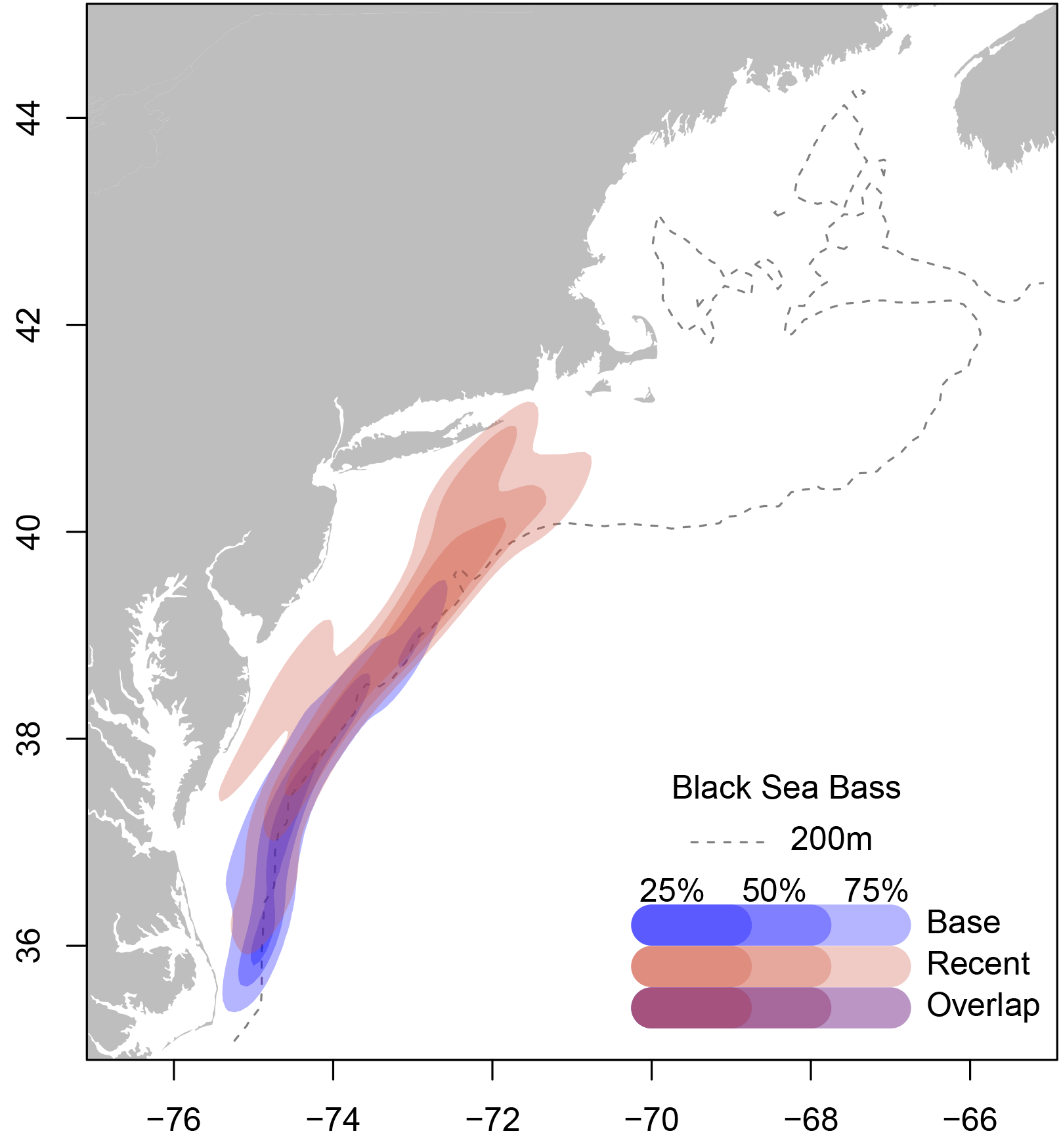 ] ] --- ## Risks: Offshore Wind Development <!--  Element: OceanUse --> .pull-left[ Indicators: development timeline, community specific revenue in lease areas <img src="20220118_Plenary1_Gaichas_files/figure-html/unnamed-chunk-55-1.png" width="504" style="display: block; margin: auto;" /> ] .pull-right[ <img src="20220118_Plenary1_Gaichas_files/figure-html/unnamed-chunk-56-1.png" width="504" style="display: block; margin: auto;" /> ] --- background-image: url("EDAB_images/MidAtlantic_2021128-01.jpg") background-size: 500px background-position: right ## Risks: Offshore Wind Development <!--  Element: OceanUse--> .pull-left[ Implications (2021--uupdate): * Current plans for rapid buildout of offshore wind in a patchwork of areas spreads the impacts differentially throughout the region * 2-24% of total average revenue for major Mid-Atlantic commercial species in lease areas could be displaced if all sites are developed. Displaced fishing effort can alter fishing methods, which can in turn change habitat, species (managed and protected), and fleet interactions. * Right whales may be displaced, and altered local oceanography could affect distribution of their zooplankton prey. * Scientific data collection surveys for ocean and ecosystem conditions, fish, and protected species will be altered, potentially increasing uncertainty for management decision making. ] .pull-right[] --- background-image: url("EDAB_images/noaa-iea.png") background-size: 350px background-position: right bottom ## Contributors - THANK YOU! The New England and Mid-Atlantic SOEs made possible by (at least) 52 contributors from 10 institutions .pull-left[ .contrib[ Andy Beet<br> Kimberly Bastille<br> Ruth Boettcher (Virginia Department of Game and Inland Fisheries)<br> Mandy Bromilow (NOAA Chesapeake Bay Office)<br> Zhuomin Chen (Woods Hole Oceanographic Institution)<br> Joseph Caracappa<br> Doug Christel (GARFO)<br> Patricia Clay<br> Lisa Colburn<br> Jennifer Cudney (NMFS Atlantic HMS Management Division)<br> Tobey Curtis (NMFS Atlantic HMS Management Division)<br> Geret DePiper<br> Emily Farr (NMFS Office of Habitat Conservation)<br> Michael Fogarty<br> Paula Fratantoni<br> Kevin Friedland<br> Sarah Gaichas<br> Ben Galuardi (GARFO)<br> Avijit Gangopadhyay (School for Marine Science and Technology, University of Massachusetts Dartmouth)<br> James Gartland (Virginia Institute of Marine Science)<br> Glen Gawarkiewicz (Woods Hole Oceanographic Institution)<br> Sean Hardison<br> Kimberly Hyde<br> John Kosik<br> Steve Kress (National Audubon Society’s Seabird Restoration Program)<br> Young-Oh Kwon (Woods Hole Oceanographic Institution)<br> ] ] .pull-right[ .contrib[ Scott Large<br> Andrew Lipsky<br> Sean Lucey Don Lyons (National Audubon Society’s Seabird Restoration Program)<br> Chris Melrose<br> Shannon Meseck<br> Ryan Morse<br> Kimberly Murray<br> Chris Orphanides<br> Richard Pace<br> Charles Perretti<br> CJ Pellerin (NOAA Chesapeake Bay Office)<br> Grace Roskar (NMFS Office of Habitat Conservation)<br> Grace Saba (Rutgers)<br> Vincent Saba<br> Chris Schillaci (GARFO)<br> Angela Silva<br> Emily Slesinger (Rutgers University)<br> Laurel Smith<br> Talya tenBrink (GARFO)<br> Bruce Vogt (NOAA Chesapeake Bay Office)<br> Ron Vogel (UMD Cooperative Institute for Satellite Earth System Studies and NOAA/NESDIS Center for Satellite Applications and Research)<br> John Walden<br> Harvey Walsh<br> Changhua Weng<br> Mark Wuenschel ] ] --- ## References .contrib[ <a name=bib-bastille_improving_2020></a>[Bastille, K. et al.](#cite-bastille_improving_2020) (2020). "Improving the IEA Approach Using Principles of Open Data Science". In: _Coastal Management_ 0.0. Publisher: Taylor & Francis \_ eprint: https://doi.org/10.1080/08920753.2021.1846155, pp. 1-18. ISSN: 0892-0753. DOI: [10.1080/08920753.2021.1846155](https://doi.org/10.1080%2F08920753.2021.1846155). URL: [https://doi.org/10.1080/08920753.2021.1846155](https://doi.org/10.1080/08920753.2021.1846155) (visited on Dec. 09, 2020). <a name=bib-depiper_operationalizing_2017></a>[DePiper, G. S. et al.](#cite-depiper_operationalizing_2017) (2017). "Operationalizing integrated ecosystem assessments within a multidisciplinary team: lessons learned from a worked example". En. In: _ICES Journal of Marine Science_ 74.8, pp. 2076-2086. ISSN: 1054-3139. DOI: [10.1093/icesjms/fsx038](https://doi.org/10.1093%2Ficesjms%2Ffsx038). URL: [https://academic.oup.com/icesjms/article/74/8/2076/3094701](https://academic.oup.com/icesjms/article/74/8/2076/3094701) (visited on Mar. 09, 2018). <a name=bib-muffley_there_2020></a>[Muffley, B. et al.](#cite-muffley_there_2020) (2020). "There Is no I in EAFM Adapting Integrated Ecosystem Assessment for Mid-Atlantic Fisheries Management". In: _Coastal Management_ 0.0. Publisher: Taylor & Francis \_ eprint: https://doi.org/10.1080/08920753.2021.1846156, pp. 1-17. ISSN: 0892-0753. DOI: [10.1080/08920753.2021.1846156](https://doi.org/10.1080%2F08920753.2021.1846156). URL: [https://doi.org/10.1080/08920753.2021.1846156](https://doi.org/10.1080/08920753.2021.1846156) (visited on Dec. 09, 2020). ] ## Additional resources .pull-left[ * [ecodata R package](https://github.com/noaa-edab/ecodata) * Visualizations: * [Mid-Atlantic Human Dimensions indicators](http://noaa-edab.github.io/ecodata/human_dimensions_MAB) * [Mid-Atlantic Macrofauna indicators](http://noaa-edab.github.io/ecodata/macrofauna_MAB) * [Mid-Atlantic Lower trophic level indicators](https://noaa-edab.github.io/ecodata/LTL_MAB) ] .pull-right[ * [SOE Reports on the web](https://www.fisheries.noaa.gov/new-england-mid-atlantic/ecosystems/state-ecosystem-reports-northeast-us-shelf) * [SOE Technical Documentation](https://noaa-edab.github.io/tech-doc) * [Draft indicator catalog](https://noaa-edab.github.io/catalog/) .contrib[ * Slides available at https://noaa-edab.github.io/presentations * Contact: <Sarah.Gaichas@noaa.gov> ] ] --- background-image: url("EDAB_images/SOE-MAFMC-2021-plusgraphicsummary_Page_01.png") background-size: 600px background-position: bottom right # Discussion .pull-left[ 1. This draft based on last year, not complete 1. Maintain structure, update based on requests 1. Further develop synthesis themes: multiple drivers, regime shifts, system reorganization 1. Note updates to be included as Request Memo points - What has been included this year - What is in progress - What has less progress - What feedback/clarification would help contributors # Thank you! ] ??? SOE has been like an annual benchmark with new data and structure... hold pattern for a few years? --- ## 2022 Request tracking memo <table class="table" style="font-size: 12px; margin-left: auto; margin-right: auto;"> <thead> <tr> <th style="text-align:left;font-weight: bold;"> Request </th> <th style="text-align:right;font-weight: bold;"> Year </th> <th style="text-align:left;font-weight: bold;"> Source </th> </tr> </thead> <tbody> <tr> <td style="text-align:left;width: 13.5cm; "> More direct convos for feedback </td> <td style="text-align:right;width: 1cm; "> 2021 </td> <td style="text-align:left;width: 13.5cm; "> MAFMC SSC - https://docs.google.com/document/d/1u-JQPpceJGzz2jddx2ssHJLlgMB7y0Jg5h_oO31Hx38/edit </td> </tr> <tr> <td style="text-align:left;width: 13.5cm; "> Add "This report is direct to..." </td> <td style="text-align:right;width: 1cm; "> 2021 </td> <td style="text-align:left;width: 13.5cm; "> MAFMC SSC - https://docs.google.com/document/d/1u-JQPpceJGzz2jddx2ssHJLlgMB7y0Jg5h_oO31Hx38/edit </td> </tr> <tr> <td style="text-align:left;width: 13.5cm; "> Further definition of regime shift - Define "abupt" and "Persistant" </td> <td style="text-align:right;width: 1cm; "> 2021 </td> <td style="text-align:left;width: 13.5cm; "> MAFMC SSC - https://docs.google.com/document/d/1u-JQPpceJGzz2jddx2ssHJLlgMB7y0Jg5h_oO31Hx38/edit </td> </tr> <tr> <td style="text-align:left;width: 13.5cm; "> Expand collaboration with Canadian Counterparts </td> <td style="text-align:right;width: 1cm; "> 2021 </td> <td style="text-align:left;width: 13.5cm; "> MAFMC SSC - https://docs.google.com/document/d/1u-JQPpceJGzz2jddx2ssHJLlgMB7y0Jg5h_oO31Hx38/edit </td> </tr> <tr> <td style="text-align:left;width: 13.5cm; "> State management objectives first in report </td> <td style="text-align:right;width: 1cm; "> 2021 </td> <td style="text-align:left;width: 13.5cm; "> NEFMC - https://docs.google.com/document/d/119fjByOtS75IZuqVAVocKZb-NSdzYF7oXpl4WDt9RwQ/edit </td> </tr> <tr> <td style="text-align:left;width: 13.5cm; "> recreational bycatch mortality as an indicator of regulatory waste </td> <td style="text-align:right;width: 1cm; "> 2021 </td> <td style="text-align:left;width: 13.5cm; "> MAFMC SSC - https://docs.google.com/document/d/1wDBu92Z4sotWjXGpqQYwc9XoSkjndoEF/edit </td> </tr> <tr> <td style="text-align:left;width: 13.5cm; "> Sturgeon Bycatch </td> <td style="text-align:right;width: 1cm; "> 2021 </td> <td style="text-align:left;width: 13.5cm; "> MAFMC SSC - https://docs.google.com/document/d/1wDBu92Z4sotWjXGpqQYwc9XoSkjndoEF/edit </td> </tr> <tr> <td style="text-align:left;width: 13.5cm; "> Sum of TAC/ Landings relative to TAC </td> <td style="text-align:right;width: 1cm; "> 2021 </td> <td style="text-align:left;width: 13.5cm; "> MAFMC SSC - https://docs.google.com/document/d/1u-JQPpceJGzz2jddx2ssHJLlgMB7y0Jg5h_oO31Hx38/edit </td> </tr> <tr> <td style="text-align:left;width: 13.5cm; "> Decomposition of diversity drivers highlighting social components </td> <td style="text-align:right;width: 1cm; "> 2021 </td> <td style="text-align:left;width: 13.5cm; "> MAFMC SSC - https://docs.google.com/document/d/1u-JQPpceJGzz2jddx2ssHJLlgMB7y0Jg5h_oO31Hx38/edit </td> </tr> <tr> <td style="text-align:left;width: 13.5cm; "> changing per capita seafood consumption as driver of revenue? </td> <td style="text-align:right;width: 1cm; "> 2021 </td> <td style="text-align:left;width: 13.5cm; "> MAFMC - https://docs.google.com/document/d/19OkkLTt00RaQ4YWx4Mrc_4CBI9iTxKJDBkl60A_D4lU/edit </td> </tr> <tr> <td style="text-align:left;width: 13.5cm; "> fall turnover date index </td> <td style="text-align:right;width: 1cm; "> 2021 </td> <td style="text-align:left;width: 13.5cm; "> MAFMC SSC - https://docs.google.com/document/d/1wDBu92Z4sotWjXGpqQYwc9XoSkjndoEF/edit </td> </tr> <tr> <td style="text-align:left;width: 13.5cm; "> Nutrient input, Benthic Flux and POC(particulate organic carbon ) to inform benthic productivity by something other than surface indidcators </td> <td style="text-align:right;width: 1cm; "> 2021 </td> <td style="text-align:left;width: 13.5cm; "> MAFMC SSC - https://docs.google.com/document/d/1u-JQPpceJGzz2jddx2ssHJLlgMB7y0Jg5h_oO31Hx38/edit </td> </tr> <tr> <td style="text-align:left;width: 13.5cm; "> OA in NEFMC SOE </td> <td style="text-align:right;width: 1cm; "> 2021 </td> <td style="text-align:left;width: 13.5cm; "> NEFMC SSC - https://docs.google.com/document/d/1jc8mpBWZSu3RUBUBdXytFzEOsJsMn9A1yBdfjFIW1FU/edit </td> </tr> <tr> <td style="text-align:left;width: 13.5cm; "> Habitat impact of fishing based on gear. </td> <td style="text-align:right;width: 1cm; "> 2021 </td> <td style="text-align:left;width: 13.5cm; "> NEFMC - https://docs.google.com/document/d/119fjByOtS75IZuqVAVocKZb-NSdzYF7oXpl4WDt9RwQ/edit </td> </tr> <tr> <td style="text-align:left;width: 13.5cm; "> relate OA to nutrient input; are there "dead zones" (hypoxia)? </td> <td style="text-align:right;width: 1cm; "> 2021 </td> <td style="text-align:left;width: 13.5cm; "> MAFMC - https://docs.google.com/document/d/19OkkLTt00RaQ4YWx4Mrc_4CBI9iTxKJDBkl60A_D4lU/edit </td> </tr> <tr> <td style="text-align:left;width: 13.5cm; "> indicators of chemical pollution in offshore waters? </td> <td style="text-align:right;width: 1cm; "> 2021 </td> <td style="text-align:left;width: 13.5cm; "> MAFMC - https://docs.google.com/document/d/19OkkLTt00RaQ4YWx4Mrc_4CBI9iTxKJDBkl60A_D4lU/edit </td> </tr> <tr> <td style="text-align:left;width: 13.5cm; "> links between species availability inshore/offshore (estuarine conditions) and trends in recreational fishing effort? </td> <td style="text-align:right;width: 1cm; "> 2021 </td> <td style="text-align:left;width: 13.5cm; "> MAFMC - https://docs.google.com/document/d/19OkkLTt00RaQ4YWx4Mrc_4CBI9iTxKJDBkl60A_D4lU/edit </td> </tr> <tr> <td style="text-align:left;width: 13.5cm; "> how does phyto size comp affect EOF indicator, if at all? </td> <td style="text-align:right;width: 1cm; "> 2021 </td> <td style="text-align:left;width: 13.5cm; "> MAFMC - https://docs.google.com/document/d/19OkkLTt00RaQ4YWx4Mrc_4CBI9iTxKJDBkl60A_D4lU/edit </td> </tr> <tr> <td style="text-align:left;width: 13.5cm; "> Revisit right whale language </td> <td style="text-align:right;width: 1cm; "> 2021 </td> <td style="text-align:left;width: 13.5cm; "> NEFMC - https://docs.google.com/document/d/119fjByOtS75IZuqVAVocKZb-NSdzYF7oXpl4WDt9RwQ/edit </td> </tr> <tr> <td style="text-align:left;width: 13.5cm; "> Indicator of scallop pred pops poorly sampled by bts </td> <td style="text-align:right;width: 1cm; "> 2021 </td> <td style="text-align:left;width: 13.5cm; "> NEFMC - https://docs.google.com/document/d/119fjByOtS75IZuqVAVocKZb-NSdzYF7oXpl4WDt9RwQ/edit </td> </tr> <tr> <td style="text-align:left;width: 13.5cm; "> Apex predator index (pinnipeds) </td> <td style="text-align:right;width: 1cm; "> 2021 </td> <td style="text-align:left;width: 13.5cm; "> NEFMC - https://docs.google.com/document/d/119fjByOtS75IZuqVAVocKZb-NSdzYF7oXpl4WDt9RwQ/edit </td> </tr> <tr> <td style="text-align:left;width: 13.5cm; "> Forage availability index (Herring/Sandlance) </td> <td style="text-align:right;width: 1cm; "> 2021 </td> <td style="text-align:left;width: 13.5cm; "> NEFMC - https://docs.google.com/document/d/119fjByOtS75IZuqVAVocKZb-NSdzYF7oXpl4WDt9RwQ/edit </td> </tr> <tr> <td style="text-align:left;width: 13.5cm; "> fishery gear modifications accounted for in shark CPUE? ask HMS </td> <td style="text-align:right;width: 1cm; "> 2021 </td> <td style="text-align:left;width: 13.5cm; "> MAFMC - https://docs.google.com/document/d/19OkkLTt00RaQ4YWx4Mrc_4CBI9iTxKJDBkl60A_D4lU/edit </td> </tr> <tr> <td style="text-align:left;width: 13.5cm; "> compare EOF (Link) thresholds to empirical thresholds (Large, Tam) </td> <td style="text-align:right;width: 1cm; "> 2021 </td> <td style="text-align:left;width: 13.5cm; "> MAFMC SSC - https://docs.google.com/document/d/1u-JQPpceJGzz2jddx2ssHJLlgMB7y0Jg5h_oO31Hx38/edit </td> </tr> <tr> <td style="text-align:left;width: 13.5cm; "> Time series analysis (Zooplankton/Forage fish) to tie into regime shifts </td> <td style="text-align:right;width: 1cm; "> 2021 </td> <td style="text-align:left;width: 13.5cm; "> MAFMC SSC - https://docs.google.com/document/d/1u-JQPpceJGzz2jddx2ssHJLlgMB7y0Jg5h_oO31Hx38/edit </td> </tr> <tr> <td style="text-align:left;width: 13.5cm; "> Trend analysis </td> <td style="text-align:right;width: 1cm; "> 2021 </td> <td style="text-align:left;width: 13.5cm; "> NEFMC SSC - https://docs.google.com/document/d/1jc8mpBWZSu3RUBUBdXytFzEOsJsMn9A1yBdfjFIW1FU/edit </td> </tr> <tr> <td style="text-align:left;width: 13.5cm; "> Regime shifts in Social-Economic indicators </td> <td style="text-align:right;width: 1cm; "> 2021 </td> <td style="text-align:left;width: 13.5cm; "> NEFMC SSC - https://docs.google.com/document/d/1jc8mpBWZSu3RUBUBdXytFzEOsJsMn9A1yBdfjFIW1FU/edit </td> </tr> <tr> <td style="text-align:left;width: 13.5cm; "> Optimum yeild for ecosystem </td> <td style="text-align:right;width: 1cm; "> 2021 </td> <td style="text-align:left;width: 13.5cm; "> NEFMC - https://docs.google.com/document/d/119fjByOtS75IZuqVAVocKZb-NSdzYF7oXpl4WDt9RwQ/edit </td> </tr> <tr> <td style="text-align:left;width: 13.5cm; "> Linking Condition </td> <td style="text-align:right;width: 1cm; "> 2020 </td> <td style="text-align:left;width: 13.5cm; "> MAFMC </td> </tr> <tr> <td style="text-align:left;width: 13.5cm; "> Re-evaluate EPUs </td> <td style="text-align:right;width: 1cm; "> 2020 </td> <td style="text-align:left;width: 13.5cm; "> NEFMC </td> </tr> <tr> <td style="text-align:left;width: 13.5cm; "> Incorporate social sciences survey from council </td> <td style="text-align:right;width: 1cm; "> 2020 </td> <td style="text-align:left;width: 13.5cm; "> NEFMC </td> </tr> <tr> <td style="text-align:left;width: 13.5cm; "> Cumulative weather index </td> <td style="text-align:right;width: 1cm; "> 2020 </td> <td style="text-align:left;width: 13.5cm; "> MAFMC </td> </tr> <tr> <td style="text-align:left;width: 13.5cm; "> VAST and uncertainty </td> <td style="text-align:right;width: 1cm; "> 2020 </td> <td style="text-align:left;width: 13.5cm; "> Both Councils </td> </tr> <tr> <td style="text-align:left;width: 13.5cm; "> Seal index </td> <td style="text-align:right;width: 1cm; "> 2020 </td> <td style="text-align:left;width: 13.5cm; "> MAFMC </td> </tr> <tr> <td style="text-align:left;width: 13.5cm; "> Biomass of spp not included in BTS </td> <td style="text-align:right;width: 1cm; "> 2020 </td> <td style="text-align:left;width: 13.5cm; "> MAFMC </td> </tr> <tr> <td style="text-align:left;width: 13.5cm; "> Reduce indicator dimensionality with multivariate statistics </td> <td style="text-align:right;width: 1cm; "> 2020 </td> <td style="text-align:left;width: 13.5cm; "> NEFMC </td> </tr> <tr> <td style="text-align:left;width: 13.5cm; "> Breakpoints </td> <td style="text-align:right;width: 1cm; "> 2020 </td> <td style="text-align:left;width: 13.5cm; "> NEFMC </td> </tr> <tr> <td style="text-align:left;width: 13.5cm; "> Management complexity </td> <td style="text-align:right;width: 1cm; "> 2019 </td> <td style="text-align:left;width: 13.5cm; "> MAFMC </td> </tr> <tr> <td style="text-align:left;width: 13.5cm; "> Shellfish growth/distribution linked to climate (system productivity) </td> <td style="text-align:right;width: 1cm; "> 2019 </td> <td style="text-align:left;width: 13.5cm; "> MAFMC </td> </tr> <tr> <td style="text-align:left;width: 13.5cm; "> Estuarine condition relative to power plants and temp </td> <td style="text-align:right;width: 1cm; "> 2019 </td> <td style="text-align:left;width: 13.5cm; "> MAFMC </td> </tr> <tr> <td style="text-align:left;width: 13.5cm; "> Avg weight of diet components by feeding group </td> <td style="text-align:right;width: 1cm; "> 2019 </td> <td style="text-align:left;width: 13.5cm; "> Internal </td> </tr> <tr> <td style="text-align:left;width: 13.5cm; "> Mean stomach weight across feeding guilds </td> <td style="text-align:right;width: 1cm; "> 2019 </td> <td style="text-align:left;width: 13.5cm; "> MAFMC </td> </tr> <tr> <td style="text-align:left;width: 13.5cm; "> Young of Year index from multiple surveys </td> <td style="text-align:right;width: 1cm; "> 2019 </td> <td style="text-align:left;width: 13.5cm; "> MAFMC </td> </tr> <tr> <td style="text-align:left;width: 13.5cm; "> Inflection points for indicators </td> <td style="text-align:right;width: 1cm; "> 2019 </td> <td style="text-align:left;width: 13.5cm; "> Both Councils </td> </tr> </tbody> </table> --- ## State of the Ecosystem → MAFMC Risk assessent example: Commercial revenue This element is applied at the ecosystem level. Revenue serves as a proxy for commercial profits. .table[ .pull-left[ <table> <thead> <tr> <th style="text-align:left;"> Risk Level </th> <th style="text-align:left;"> Definition </th> </tr> </thead> <tbody> <tr> <td style="text-align:left;width: 20em; "> Low </td> <td style="text-align:left;width: 20em; "> No trend and low variability in revenue </td> </tr> <tr> <td style="text-align:left;width: 20em; "> Low-Moderate </td> <td style="text-align:left;width: 20em; "> Increasing or high variability in revenue </td> </tr> <tr> <td style="text-align:left;width: 20em; font-weight: bold;background-color: orange !important;"> Moderate-High </td> <td style="text-align:left;width: 20em; font-weight: bold;background-color: orange !important;"> Significant long term revenue decrease </td> </tr> <tr> <td style="text-align:left;width: 20em; "> High </td> <td style="text-align:left;width: 20em; "> Significant recent decrease in revenue </td> </tr> </tbody> </table> Ranked moderate-high risk due to the significant long term revenue decrease for Mid-Atlantic managed species (red points in top plot) ] ] .pull-right[ <img src="20220118_Plenary1_Gaichas_files/figure-html/unnamed-chunk-58-1.png" width="504" style="display: block; margin: auto;" /> Key: Black = Revenue of all species combined; <p style="color:#FF6A6A;">Red = Revenue of MAFMC managed species</p> ] -- ## Risk element: <span style="background-color:orange;">CommRev</span>, unchanged --- ## EAFM Risk Assessment: 2021 Update .pull-left[ *Species level risk elements* <table class="risktable table" style="font-size: 9px; margin-left: auto; margin-right: auto;"> <thead> <tr> <th style="text-align:left;"> Species </th> <th style="text-align:left;"> Assess </th> <th style="text-align:left;"> Fstatus </th> <th style="text-align:left;"> Bstatus </th> <th style="text-align:left;"> FW1Pred </th> <th style="text-align:left;"> FW1Prey </th> <th style="text-align:left;"> FW2Prey </th> <th style="text-align:left;"> Climate </th> <th style="text-align:left;"> DistShift </th> <th style="text-align:left;"> EstHabitat </th> </tr> </thead> <tbody> <tr> <td style="text-align:left;"> Ocean Quahog </td> <td style="text-align:left;"> <span style=" color: black !important;padding-right: 4px; padding-left: 4px; background-color: lightgreen !important;text-align: c;">lowest</span> </td> <td style="text-align:left;"> <span style=" color: black !important;padding-right: 4px; padding-left: 4px; background-color: lightgreen !important;text-align: c;">lowest</span> </td> <td style="text-align:left;"> <span style=" color: black !important;padding-right: 4px; padding-left: 4px; background-color: lightgreen !important;text-align: c;">lowest</span> </td> <td style="text-align:left;"> <span style=" color: black !important;padding-right: 4px; padding-left: 4px; background-color: lightgreen !important;text-align: c;">lowest</span> </td> <td style="text-align:left;"> <span style=" color: black !important;padding-right: 4px; padding-left: 4px; background-color: lightgreen !important;text-align: c;">lowest</span> </td> <td style="text-align:left;"> <span style=" color: black !important;padding-right: 4px; padding-left: 4px; background-color: lightgreen !important;text-align: c;">lowest</span> </td> <td style="text-align:left;"> <span style=" color: white !important;padding-right: 4px; padding-left: 4px; background-color: red !important;text-align: c;">highest</span> </td> <td style="text-align:left;"> <span style=" color: black !important;padding-right: 4px; padding-left: 4px; background-color: orange !important;text-align: c;">modhigh</span> </td> <td style="text-align:left;"> <span style=" color: black !important;padding-right: 4px; padding-left: 4px; background-color: lightgreen !important;text-align: c;">lowest</span> </td> </tr> <tr> <td style="text-align:left;"> Surfclam </td> <td style="text-align:left;"> <span style=" color: black !important;padding-right: 4px; padding-left: 4px; background-color: lightgreen !important;text-align: c;">lowest</span> </td> <td style="text-align:left;"> <span style=" color: black !important;padding-right: 4px; padding-left: 4px; background-color: lightgreen !important;text-align: c;">lowest</span> </td> <td style="text-align:left;"> <span style=" color: black !important;padding-right: 4px; padding-left: 4px; background-color: lightgreen !important;text-align: c;">lowest</span> </td> <td style="text-align:left;"> <span style=" color: black !important;padding-right: 4px; padding-left: 4px; background-color: lightgreen !important;text-align: c;">lowest</span> </td> <td style="text-align:left;"> <span style=" color: black !important;padding-right: 4px; padding-left: 4px; background-color: lightgreen !important;text-align: c;">lowest</span> </td> <td style="text-align:left;"> <span style=" color: black !important;padding-right: 4px; padding-left: 4px; background-color: lightgreen !important;text-align: c;">lowest</span> </td> <td style="text-align:left;"> <span style=" color: black !important;padding-right: 4px; padding-left: 4px; background-color: orange !important;text-align: c;">modhigh</span> </td> <td style="text-align:left;"> <span style=" color: black !important;padding-right: 4px; padding-left: 4px; background-color: orange !important;text-align: c;">modhigh</span> </td> <td style="text-align:left;"> <span style=" color: black !important;padding-right: 4px; padding-left: 4px; background-color: lightgreen !important;text-align: c;">lowest</span> </td> </tr> <tr> <td style="text-align:left;"> Summer flounder </td> <td style="text-align:left;"> <span style=" color: black !important;padding-right: 4px; padding-left: 4px; background-color: lightgreen !important;text-align: c;">lowest</span> </td> <td style="text-align:left;"> <span style=" color: black !important;padding-right: 4px; padding-left: 4px; background-color: lightgreen !important;text-align: c;">lowest</span> </td> <td style="text-align:left;"> <span style=" color: black !important;padding-right: 4px; padding-left: 4px; background-color: yellow !important;text-align: c;">lowmod</span> </td> <td style="text-align:left;"> <span style=" color: black !important;padding-right: 4px; padding-left: 4px; background-color: lightgreen !important;text-align: c;">lowest</span> </td> <td style="text-align:left;"> <span style=" color: black !important;padding-right: 4px; padding-left: 4px; background-color: lightgreen !important;text-align: c;">lowest</span> </td> <td style="text-align:left;"> <span style=" color: black !important;padding-right: 4px; padding-left: 4px; background-color: lightgreen !important;text-align: c;">lowest</span> </td> <td style="text-align:left;"> <span style=" color: black !important;padding-right: 4px; padding-left: 4px; background-color: yellow !important;text-align: c;">lowmod</span> </td> <td style="text-align:left;"> <span style=" color: black !important;padding-right: 4px; padding-left: 4px; background-color: orange !important;text-align: c;">modhigh</span> </td> <td style="text-align:left;"> <span style=" color: white !important;padding-right: 4px; padding-left: 4px; background-color: red !important;text-align: c;">highest</span> </td> </tr> <tr> <td style="text-align:left;"> Scup </td> <td style="text-align:left;"> <span style=" color: black !important;padding-right: 4px; padding-left: 4px; background-color: lightgreen !important;text-align: c;">lowest</span> </td> <td style="text-align:left;"> <span style=" color: black !important;padding-right: 4px; padding-left: 4px; background-color: lightgreen !important;text-align: c;">lowest</span> </td> <td style="text-align:left;"> <span style=" color: black !important;padding-right: 4px; padding-left: 4px; background-color: lightgreen !important;text-align: c;">lowest</span> </td> <td style="text-align:left;"> <span style=" color: black !important;padding-right: 4px; padding-left: 4px; background-color: lightgreen !important;text-align: c;">lowest</span> </td> <td style="text-align:left;"> <span style=" color: black !important;padding-right: 4px; padding-left: 4px; background-color: lightgreen !important;text-align: c;">lowest</span> </td> <td style="text-align:left;"> <span style=" color: black !important;padding-right: 4px; padding-left: 4px; background-color: lightgreen !important;text-align: c;">lowest</span> </td> <td style="text-align:left;"> <span style=" color: black !important;padding-right: 4px; padding-left: 4px; background-color: yellow !important;text-align: c;">lowmod</span> </td> <td style="text-align:left;"> <span style=" color: black !important;padding-right: 4px; padding-left: 4px; background-color: orange !important;text-align: c;">modhigh</span> </td> <td style="text-align:left;"> <span style=" color: white !important;padding-right: 4px; padding-left: 4px; background-color: red !important;text-align: c;">highest</span> </td> </tr> <tr> <td style="text-align:left;"> Black sea bass </td> <td style="text-align:left;"> <span style=" color: black !important;padding-right: 4px; padding-left: 4px; background-color: lightgreen !important;text-align: c;">lowest</span> </td> <td style="text-align:left;"> <span style=" color: black !important;padding-right: 4px; padding-left: 4px; background-color: lightgreen !important;text-align: c;">lowest</span> </td> <td style="text-align:left;"> <span style=" color: black !important;padding-right: 4px; padding-left: 4px; background-color: lightgreen !important;text-align: c;">lowest</span> </td> <td style="text-align:left;"> <span style=" color: black !important;padding-right: 4px; padding-left: 4px; background-color: lightgreen !important;text-align: c;">lowest</span> </td> <td style="text-align:left;"> <span style=" color: black !important;padding-right: 4px; padding-left: 4px; background-color: lightgreen !important;text-align: c;">lowest</span> </td> <td style="text-align:left;"> <span style=" color: black !important;padding-right: 4px; padding-left: 4px; background-color: lightgreen !important;text-align: c;">lowest</span> </td> <td style="text-align:left;"> <span style=" color: black !important;padding-right: 4px; padding-left: 4px; background-color: orange !important;text-align: c;">modhigh</span> </td> <td style="text-align:left;"> <span style=" color: black !important;padding-right: 4px; padding-left: 4px; background-color: orange !important;text-align: c;">modhigh</span> </td> <td style="text-align:left;"> <span style=" color: white !important;padding-right: 4px; padding-left: 4px; background-color: red !important;text-align: c;">highest</span> </td> </tr> <tr> <td style="text-align:left;"> Atl. mackerel </td> <td style="text-align:left;"> <span style=" color: black !important;padding-right: 4px; padding-left: 4px; background-color: lightgreen !important;text-align: c;">lowest</span> </td> <td style="text-align:left;"> <span style=" color: white !important;padding-right: 4px; padding-left: 4px; background-color: red !important;text-align: c;">highest</span> </td> <td style="text-align:left;"> <span style=" color: white !important;padding-right: 4px; padding-left: 4px; background-color: red !important;text-align: c;">highest</span> </td> <td style="text-align:left;"> <span style=" color: black !important;padding-right: 4px; padding-left: 4px; background-color: lightgreen !important;text-align: c;">lowest</span> </td> <td style="text-align:left;"> <span style=" color: black !important;padding-right: 4px; padding-left: 4px; background-color: lightgreen !important;text-align: c;">lowest</span> </td> <td style="text-align:left;"> <span style=" color: black !important;padding-right: 4px; padding-left: 4px; background-color: lightgreen !important;text-align: c;">lowest</span> </td> <td style="text-align:left;"> <span style=" color: black !important;padding-right: 4px; padding-left: 4px; background-color: yellow !important;text-align: c;">lowmod</span> </td> <td style="text-align:left;"> <span style=" color: black !important;padding-right: 4px; padding-left: 4px; background-color: orange !important;text-align: c;">modhigh</span> </td> <td style="text-align:left;"> <span style=" color: black !important;padding-right: 4px; padding-left: 4px; background-color: lightgreen !important;text-align: c;">lowest</span> </td> </tr> <tr> <td style="text-align:left;"> Butterfish </td> <td style="text-align:left;"> <span style=" color: black !important;padding-right: 4px; padding-left: 4px; background-color: lightgreen !important;text-align: c;">lowest</span> </td> <td style="text-align:left;"> <span style=" color: black !important;padding-right: 4px; padding-left: 4px; background-color: lightgreen !important;text-align: c;">lowest</span> </td> <td style="text-align:left;"> <span style=" color: black !important;padding-right: 4px; padding-left: 4px; background-color: yellow !important;text-align: c;">lowmod</span> </td> <td style="text-align:left;"> <span style=" color: black !important;padding-right: 4px; padding-left: 4px; background-color: lightgreen !important;text-align: c;">lowest</span> </td> <td style="text-align:left;"> <span style=" color: black !important;padding-right: 4px; padding-left: 4px; background-color: lightgreen !important;text-align: c;">lowest</span> </td> <td style="text-align:left;"> <span style=" color: black !important;padding-right: 4px; padding-left: 4px; background-color: lightgreen !important;text-align: c;">lowest</span> </td> <td style="text-align:left;"> <span style=" color: black !important;padding-right: 4px; padding-left: 4px; background-color: lightgreen !important;text-align: c;">lowest</span> </td> <td style="text-align:left;"> <span style=" color: white !important;padding-right: 4px; padding-left: 4px; background-color: red !important;text-align: c;">highest</span> </td> <td style="text-align:left;"> <span style=" color: black !important;padding-right: 4px; padding-left: 4px; background-color: lightgreen !important;text-align: c;">lowest</span> </td> </tr> <tr> <td style="text-align:left;"> Longfin squid </td> <td style="text-align:left;"> <span style=" color: black !important;padding-right: 4px; padding-left: 4px; background-color: yellow !important;text-align: c;">lowmod</span> </td> <td style="text-align:left;"> <span style=" color: black !important;padding-right: 4px; padding-left: 4px; background-color: yellow !important;text-align: c;">lowmod</span> </td> <td style="text-align:left;"> <span style=" color: black !important;padding-right: 4px; padding-left: 4px; background-color: yellow !important;text-align: c;">lowmod</span> </td> <td style="text-align:left;"> <span style=" color: black !important;padding-right: 4px; padding-left: 4px; background-color: lightgreen !important;text-align: c;">lowest</span> </td> <td style="text-align:left;"> <span style=" color: black !important;padding-right: 4px; padding-left: 4px; background-color: lightgreen !important;text-align: c;">lowest</span> </td> <td style="text-align:left;"> <span style=" color: black !important;padding-right: 4px; padding-left: 4px; background-color: yellow !important;text-align: c;">lowmod</span> </td> <td style="text-align:left;"> <span style=" color: black !important;padding-right: 4px; padding-left: 4px; background-color: lightgreen !important;text-align: c;">lowest</span> </td> <td style="text-align:left;"> <span style=" color: black !important;padding-right: 4px; padding-left: 4px; background-color: orange !important;text-align: c;">modhigh</span> </td> <td style="text-align:left;"> <span style=" color: black !important;padding-right: 4px; padding-left: 4px; background-color: lightgreen !important;text-align: c;">lowest</span> </td> </tr> <tr> <td style="text-align:left;"> Shortfin squid </td> <td style="text-align:left;"> <span style=" color: black !important;padding-right: 4px; padding-left: 4px; background-color: yellow !important;text-align: c;">lowmod</span> </td> <td style="text-align:left;"> <span style=" color: black !important;padding-right: 4px; padding-left: 4px; background-color: yellow !important;text-align: c;">lowmod</span> </td> <td style="text-align:left;"> <span style=" color: black !important;padding-right: 4px; padding-left: 4px; background-color: yellow !important;text-align: c;">lowmod</span> </td> <td style="text-align:left;"> <span style=" color: black !important;padding-right: 4px; padding-left: 4px; background-color: lightgreen !important;text-align: c;">lowest</span> </td> <td style="text-align:left;"> <span style=" color: black !important;padding-right: 4px; padding-left: 4px; background-color: lightgreen !important;text-align: c;">lowest</span> </td> <td style="text-align:left;"> <span style=" color: black !important;padding-right: 4px; padding-left: 4px; background-color: yellow !important;text-align: c;">lowmod</span> </td> <td style="text-align:left;"> <span style=" color: black !important;padding-right: 4px; padding-left: 4px; background-color: lightgreen !important;text-align: c;">lowest</span> </td> <td style="text-align:left;"> <span style=" color: white !important;padding-right: 4px; padding-left: 4px; background-color: red !important;text-align: c;">highest</span> </td> <td style="text-align:left;"> <span style=" color: black !important;padding-right: 4px; padding-left: 4px; background-color: lightgreen !important;text-align: c;">lowest</span> </td> </tr> <tr> <td style="text-align:left;"> Golden tilefish </td> <td style="text-align:left;"> <span style=" color: black !important;padding-right: 4px; padding-left: 4px; background-color: lightgreen !important;text-align: c;">lowest</span> </td> <td style="text-align:left;"> <span style=" color: black !important;padding-right: 4px; padding-left: 4px; background-color: lightgreen !important;text-align: c;">lowest</span> </td> <td style="text-align:left;"> <span style=" color: black !important;padding-right: 4px; padding-left: 4px; background-color: yellow !important;text-align: c;">lowmod</span> </td> <td style="text-align:left;"> <span style=" color: black !important;padding-right: 4px; padding-left: 4px; background-color: lightgreen !important;text-align: c;">lowest</span> </td> <td style="text-align:left;"> <span style=" color: black !important;padding-right: 4px; padding-left: 4px; background-color: lightgreen !important;text-align: c;">lowest</span> </td> <td style="text-align:left;"> <span style=" color: black !important;padding-right: 4px; padding-left: 4px; background-color: lightgreen !important;text-align: c;">lowest</span> </td> <td style="text-align:left;"> <span style=" color: black !important;padding-right: 4px; padding-left: 4px; background-color: orange !important;text-align: c;">modhigh</span> </td> <td style="text-align:left;"> <span style=" color: black !important;padding-right: 4px; padding-left: 4px; background-color: lightgreen !important;text-align: c;">lowest</span> </td> <td style="text-align:left;"> <span style=" color: black !important;padding-right: 4px; padding-left: 4px; background-color: lightgreen !important;text-align: c;">lowest</span> </td> </tr> <tr> <td style="text-align:left;"> Blueline tilefish </td> <td style="text-align:left;"> <span style=" color: white !important;padding-right: 4px; padding-left: 4px; background-color: red !important;text-align: c;">highest</span> </td> <td style="text-align:left;"> <span style=" color: white !important;padding-right: 4px; padding-left: 4px; background-color: red !important;text-align: c;">highest</span> </td> <td style="text-align:left;"> <span style=" color: black !important;padding-right: 4px; padding-left: 4px; background-color: orange !important;text-align: c;">modhigh</span> </td> <td style="text-align:left;"> <span style=" color: black !important;padding-right: 4px; padding-left: 4px; background-color: lightgreen !important;text-align: c;">lowest</span> </td> <td style="text-align:left;"> <span style=" color: black !important;padding-right: 4px; padding-left: 4px; background-color: lightgreen !important;text-align: c;">lowest</span> </td> <td style="text-align:left;"> <span style=" color: black !important;padding-right: 4px; padding-left: 4px; background-color: lightgreen !important;text-align: c;">lowest</span> </td> <td style="text-align:left;"> <span style=" color: black !important;padding-right: 4px; padding-left: 4px; background-color: orange !important;text-align: c;">modhigh</span> </td> <td style="text-align:left;"> <span style=" color: black !important;padding-right: 4px; padding-left: 4px; background-color: lightgreen !important;text-align: c;">lowest</span> </td> <td style="text-align:left;"> <span style=" color: black !important;padding-right: 4px; padding-left: 4px; background-color: lightgreen !important;text-align: c;">lowest</span> </td> </tr> <tr> <td style="text-align:left;"> Bluefish </td> <td style="text-align:left;"> <span style=" color: black !important;padding-right: 4px; padding-left: 4px; background-color: lightgreen !important;text-align: c;">lowest</span> </td> <td style="text-align:left;"> <span style=" color: black !important;padding-right: 4px; padding-left: 4px; background-color: lightgreen !important;text-align: c;">lowest</span> </td> <td style="text-align:left;"> <span style=" color: white !important;padding-right: 4px; padding-left: 4px; background-color: red !important;text-align: c;">highest</span> </td> <td style="text-align:left;"> <span style=" color: black !important;padding-right: 4px; padding-left: 4px; background-color: lightgreen !important;text-align: c;">lowest</span> </td> <td style="text-align:left;"> <span style=" color: black !important;padding-right: 4px; padding-left: 4px; background-color: lightgreen !important;text-align: c;">lowest</span> </td> <td style="text-align:left;"> <span style=" color: black !important;padding-right: 4px; padding-left: 4px; background-color: lightgreen !important;text-align: c;">lowest</span> </td> <td style="text-align:left;"> <span style=" color: black !important;padding-right: 4px; padding-left: 4px; background-color: lightgreen !important;text-align: c;">lowest</span> </td> <td style="text-align:left;"> <span style=" color: black !important;padding-right: 4px; padding-left: 4px; background-color: orange !important;text-align: c;">modhigh</span> </td> <td style="text-align:left;"> <span style=" color: white !important;padding-right: 4px; padding-left: 4px; background-color: red !important;text-align: c;">highest</span> </td> </tr> <tr> <td style="text-align:left;"> Spiny dogfish </td> <td style="text-align:left;"> <span style=" color: black !important;padding-right: 4px; padding-left: 4px; background-color: yellow !important;text-align: c;">lowmod</span> </td> <td style="text-align:left;"> <span style=" color: black !important;padding-right: 4px; padding-left: 4px; background-color: lightgreen !important;text-align: c;">lowest</span> </td> <td style="text-align:left;"> <span style=" color: black !important;padding-right: 4px; padding-left: 4px; background-color: yellow !important;text-align: c;">lowmod</span> </td> <td style="text-align:left;"> <span style=" color: black !important;padding-right: 4px; padding-left: 4px; background-color: lightgreen !important;text-align: c;">lowest</span> </td> <td style="text-align:left;"> <span style=" color: black !important;padding-right: 4px; padding-left: 4px; background-color: lightgreen !important;text-align: c;">lowest</span> </td> <td style="text-align:left;"> <span style=" color: black !important;padding-right: 4px; padding-left: 4px; background-color: lightgreen !important;text-align: c;">lowest</span> </td> <td style="text-align:left;"> <span style=" color: black !important;padding-right: 4px; padding-left: 4px; background-color: lightgreen !important;text-align: c;">lowest</span> </td> <td style="text-align:left;"> <span style=" color: white !important;padding-right: 4px; padding-left: 4px; background-color: red !important;text-align: c;">highest</span> </td> <td style="text-align:left;"> <span style=" color: black !important;padding-right: 4px; padding-left: 4px; background-color: lightgreen !important;text-align: c;">lowest</span> </td> </tr> <tr> <td style="text-align:left;"> Monkfish </td> <td style="text-align:left;"> <span style=" color: white !important;padding-right: 4px; padding-left: 4px; background-color: red !important;text-align: c;">highest</span> </td> <td style="text-align:left;"> <span style=" color: black !important;padding-right: 4px; padding-left: 4px; background-color: yellow !important;text-align: c;">lowmod</span> </td> <td style="text-align:left;"> <span style=" color: black !important;padding-right: 4px; padding-left: 4px; background-color: yellow !important;text-align: c;">lowmod</span> </td> <td style="text-align:left;"> <span style=" color: black !important;padding-right: 4px; padding-left: 4px; background-color: lightgreen !important;text-align: c;">lowest</span> </td> <td style="text-align:left;"> <span style=" color: black !important;padding-right: 4px; padding-left: 4px; background-color: lightgreen !important;text-align: c;">lowest</span> </td> <td style="text-align:left;"> <span style=" color: black !important;padding-right: 4px; padding-left: 4px; background-color: lightgreen !important;text-align: c;">lowest</span> </td> <td style="text-align:left;"> <span style=" color: black !important;padding-right: 4px; padding-left: 4px; background-color: lightgreen !important;text-align: c;">lowest</span> </td> <td style="text-align:left;"> <span style=" color: black !important;padding-right: 4px; padding-left: 4px; background-color: orange !important;text-align: c;">modhigh</span> </td> <td style="text-align:left;"> <span style=" color: black !important;padding-right: 4px; padding-left: 4px; background-color: lightgreen !important;text-align: c;">lowest</span> </td> </tr> <tr> <td style="text-align:left;"> Unmanaged forage </td> <td style="text-align:left;"> <span style=" color: black !important;padding-right: 4px; padding-left: 4px; background-color: white !important;text-align: c;">na</span> </td> <td style="text-align:left;"> <span style=" color: black !important;padding-right: 4px; padding-left: 4px; background-color: white !important;text-align: c;">na</span> </td> <td style="text-align:left;"> <span style=" color: black !important;padding-right: 4px; padding-left: 4px; background-color: white !important;text-align: c;">na</span> </td> <td style="text-align:left;"> <span style=" color: black !important;padding-right: 4px; padding-left: 4px; background-color: lightgreen !important;text-align: c;">lowest</span> </td> <td style="text-align:left;"> <span style=" color: black !important;padding-right: 4px; padding-left: 4px; background-color: yellow !important;text-align: c;">lowmod</span> </td> <td style="text-align:left;"> <span style=" color: black !important;padding-right: 4px; padding-left: 4px; background-color: yellow !important;text-align: c;">lowmod</span> </td> <td style="text-align:left;"> <span style=" color: black !important;padding-right: 4px; padding-left: 4px; background-color: white !important;text-align: c;">na</span> </td> <td style="text-align:left;"> <span style=" color: black !important;padding-right: 4px; padding-left: 4px; background-color: white !important;text-align: c;">na</span> </td> <td style="text-align:left;"> <span style=" color: black !important;padding-right: 4px; padding-left: 4px; background-color: white !important;text-align: c;">na</span> </td> </tr> <tr> <td style="text-align:left;"> Deepsea corals </td> <td style="text-align:left;"> <span style=" color: black !important;padding-right: 4px; padding-left: 4px; background-color: white !important;text-align: c;">na</span> </td> <td style="text-align:left;"> <span style=" color: black !important;padding-right: 4px; padding-left: 4px; background-color: white !important;text-align: c;">na</span> </td> <td style="text-align:left;"> <span style=" color: black !important;padding-right: 4px; padding-left: 4px; background-color: white !important;text-align: c;">na</span> </td> <td style="text-align:left;"> <span style=" color: black !important;padding-right: 4px; padding-left: 4px; background-color: lightgreen !important;text-align: c;">lowest</span> </td> <td style="text-align:left;"> <span style=" color: black !important;padding-right: 4px; padding-left: 4px; background-color: lightgreen !important;text-align: c;">lowest</span> </td> <td style="text-align:left;"> <span style=" color: black !important;padding-right: 4px; padding-left: 4px; background-color: lightgreen !important;text-align: c;">lowest</span> </td> <td style="text-align:left;"> <span style=" color: black !important;padding-right: 4px; padding-left: 4px; background-color: white !important;text-align: c;">na</span> </td> <td style="text-align:left;"> <span style=" color: black !important;padding-right: 4px; padding-left: 4px; background-color: white !important;text-align: c;">na</span> </td> <td style="text-align:left;"> <span style=" color: black !important;padding-right: 4px; padding-left: 4px; background-color: white !important;text-align: c;">na</span> </td> </tr> </tbody> </table> .contrib[ * Butterfish B status risk increased from lowest to low-mod (below Bmsy) ] *Ecosystem level risk elements* <table class="risktable table" style="font-size: 9px; margin-left: auto; margin-right: auto;"> <thead> <tr> <th style="text-align:left;"> System </th> <th style="text-align:left;"> EcoProd </th> <th style="text-align:left;"> CommRev </th> <th style="text-align:left;"> RecVal </th> <th style="text-align:left;"> FishRes1 </th> <th style="text-align:left;"> FishRes4 </th> <th style="text-align:left;"> FleetDiv </th> <th style="text-align:left;"> Social </th> <th style="text-align:left;"> ComFood </th> <th style="text-align:left;"> RecFood </th> </tr> </thead> <tbody> <tr> <td style="text-align:left;"> Mid-Atlantic </td> <td style="text-align:left;"> <span style=" color: black !important;padding-right: 4px; padding-left: 4px; background-color: yellow !important;text-align: c;">lowmod</span> </td> <td style="text-align:left;"> <span style=" color: black !important;padding-right: 4px; padding-left: 4px; background-color: orange !important;text-align: c;">modhigh</span> </td> <td style="text-align:left;"> <span style=" color: white !important;padding-right: 4px; padding-left: 4px; background-color: red !important;text-align: c;">highest</span> </td> <td style="text-align:left;"> <span style=" color: black !important;padding-right: 4px; padding-left: 4px; background-color: lightgreen !important;text-align: c;">lowest</span> </td> <td style="text-align:left;"> <span style=" color: black !important;padding-right: 4px; padding-left: 4px; background-color: orange !important;text-align: c;">modhigh</span> </td> <td style="text-align:left;"> <span style=" color: black !important;padding-right: 4px; padding-left: 4px; background-color: lightgreen !important;text-align: c;">lowest</span> </td> <td style="text-align:left;"> <span style=" color: black !important;padding-right: 4px; padding-left: 4px; background-color: yellow !important;text-align: c;">lowmod</span> </td> <td style="text-align:left;"> <span style=" color: white !important;padding-right: 4px; padding-left: 4px; background-color: red !important;text-align: c;">highest</span> </td> <td style="text-align:left;"> <span style=" color: black !important;padding-right: 4px; padding-left: 4px; background-color: orange !important;text-align: c;">modhigh</span> </td> </tr> </tbody> </table> ] .pull-right[ *Species and Sector level risk elements* <table class="risktable table" style="font-size: 11px; margin-left: auto; margin-right: auto;"> <thead> <tr> <th style="text-align:left;"> Species </th> <th style="text-align:left;"> MgtControl </th> <th style="text-align:left;"> TecInteract </th> <th style="text-align:left;"> OceanUse </th> <th style="text-align:left;"> RegComplex </th> <th style="text-align:left;"> Discards </th> <th style="text-align:left;"> Allocation </th> </tr> </thead> <tbody> <tr> <td style="text-align:left;"> Ocean Quahog-C </td> <td style="text-align:left;"> <span style=" color: black !important;padding-right: 4px; padding-left: 4px; background-color: lightgreen !important;text-align: c;">lowest</span> </td> <td style="text-align:left;"> <span style=" color: black !important;padding-right: 4px; padding-left: 4px; background-color: lightgreen !important;text-align: c;">lowest</span> </td> <td style="text-align:left;"> <span style=" color: black !important;padding-right: 4px; padding-left: 4px; background-color: yellow !important;text-align: c;">lowmod</span> </td> <td style="text-align:left;"> <span style=" color: black !important;padding-right: 4px; padding-left: 4px; background-color: lightgreen !important;text-align: c;">lowest</span> </td> <td style="text-align:left;"> <span style=" color: black !important;padding-right: 4px; padding-left: 4px; background-color: orange !important;text-align: c;">modhigh</span> </td> <td style="text-align:left;"> <span style=" color: black !important;padding-right: 4px; padding-left: 4px; background-color: lightgreen !important;text-align: c;">lowest</span> </td> </tr> <tr> <td style="text-align:left;"> Surfclam-C </td> <td style="text-align:left;"> <span style=" color: black !important;padding-right: 4px; padding-left: 4px; background-color: lightgreen !important;text-align: c;">lowest</span> </td> <td style="text-align:left;"> <span style=" color: black !important;padding-right: 4px; padding-left: 4px; background-color: lightgreen !important;text-align: c;">lowest</span> </td> <td style="text-align:left;"> <span style=" color: black !important;padding-right: 4px; padding-left: 4px; background-color: yellow !important;text-align: c;">lowmod</span> </td> <td style="text-align:left;"> <span style=" color: black !important;padding-right: 4px; padding-left: 4px; background-color: lightgreen !important;text-align: c;">lowest</span> </td> <td style="text-align:left;"> <span style=" color: black !important;padding-right: 4px; padding-left: 4px; background-color: orange !important;text-align: c;">modhigh</span> </td> <td style="text-align:left;"> <span style=" color: black !important;padding-right: 4px; padding-left: 4px; background-color: lightgreen !important;text-align: c;">lowest</span> </td> </tr> <tr> <td style="text-align:left;"> Summer flounder-R </td> <td style="text-align:left;"> <span style=" color: black !important;padding-right: 4px; padding-left: 4px; background-color: orange !important;text-align: c;">modhigh</span> </td> <td style="text-align:left;"> <span style=" color: black !important;padding-right: 4px; padding-left: 4px; background-color: lightgreen !important;text-align: c;">lowest</span> </td> <td style="text-align:left;"> <span style=" color: black !important;padding-right: 4px; padding-left: 4px; background-color: yellow !important;text-align: c;">lowmod</span> </td> <td style="text-align:left;"> <span style=" color: black !important;padding-right: 4px; padding-left: 4px; background-color: orange !important;text-align: c;">modhigh</span> </td> <td style="text-align:left;"> <span style=" color: white !important;padding-right: 4px; padding-left: 4px; background-color: red !important;text-align: c;">highest</span> </td> <td style="text-align:left;"> <span style=" color: white !important;padding-right: 4px; padding-left: 4px; background-color: red !important;text-align: c;">highest</span> </td> </tr> <tr> <td style="text-align:left;"> Summer flounder-C </td> <td style="text-align:left;"> <span style=" color: black !important;padding-right: 4px; padding-left: 4px; background-color: yellow !important;text-align: c;">lowmod</span> </td> <td style="text-align:left;"> <span style=" color: black !important;padding-right: 4px; padding-left: 4px; background-color: orange !important;text-align: c;">modhigh</span> </td> <td style="text-align:left;"> <span style=" color: black !important;padding-right: 4px; padding-left: 4px; background-color: yellow !important;text-align: c;">lowmod</span> </td> <td style="text-align:left;"> <span style=" color: black !important;padding-right: 4px; padding-left: 4px; background-color: orange !important;text-align: c;">modhigh</span> </td> <td style="text-align:left;"> <span style=" color: black !important;padding-right: 4px; padding-left: 4px; background-color: orange !important;text-align: c;">modhigh</span> </td> <td style="text-align:left;"> <span style=" color: white !important;padding-right: 4px; padding-left: 4px; background-color: red !important;text-align: c;">highest</span> </td> </tr> <tr> <td style="text-align:left;"> Scup-R </td> <td style="text-align:left;"> <span style=" color: black !important;padding-right: 4px; padding-left: 4px; background-color: yellow !important;text-align: c;">lowmod</span> </td> <td style="text-align:left;"> <span style=" color: black !important;padding-right: 4px; padding-left: 4px; background-color: lightgreen !important;text-align: c;">lowest</span> </td> <td style="text-align:left;"> <span style=" color: black !important;padding-right: 4px; padding-left: 4px; background-color: yellow !important;text-align: c;">lowmod</span> </td> <td style="text-align:left;"> <span style=" color: black !important;padding-right: 4px; padding-left: 4px; background-color: orange !important;text-align: c;">modhigh</span> </td> <td style="text-align:left;"> <span style=" color: black !important;padding-right: 4px; padding-left: 4px; background-color: orange !important;text-align: c;">modhigh</span> </td> <td style="text-align:left;"> <span style=" color: white !important;padding-right: 4px; padding-left: 4px; background-color: red !important;text-align: c;">highest</span> </td> </tr> <tr> <td style="text-align:left;"> Scup-C </td> <td style="text-align:left;"> <span style=" color: black !important;padding-right: 4px; padding-left: 4px; background-color: lightgreen !important;text-align: c;">lowest</span> </td> <td style="text-align:left;"> <span style=" color: black !important;padding-right: 4px; padding-left: 4px; background-color: yellow !important;text-align: c;">lowmod</span> </td> <td style="text-align:left;"> <span style=" color: black !important;padding-right: 4px; padding-left: 4px; background-color: orange !important;text-align: c;">modhigh</span> </td> <td style="text-align:left;"> <span style=" color: black !important;padding-right: 4px; padding-left: 4px; background-color: orange !important;text-align: c;">modhigh</span> </td> <td style="text-align:left;"> <span style=" color: black !important;padding-right: 4px; padding-left: 4px; background-color: orange !important;text-align: c;">modhigh</span> </td> <td style="text-align:left;"> <span style=" color: white !important;padding-right: 4px; padding-left: 4px; background-color: red !important;text-align: c;">highest</span> </td> </tr> <tr> <td style="text-align:left;"> Black sea bass-R </td> <td style="text-align:left;"> <span style=" color: white !important;padding-right: 4px; padding-left: 4px; background-color: red !important;text-align: c;">highest</span> </td> <td style="text-align:left;"> <span style=" color: black !important;padding-right: 4px; padding-left: 4px; background-color: lightgreen !important;text-align: c;">lowest</span> </td> <td style="text-align:left;"> <span style=" color: black !important;padding-right: 4px; padding-left: 4px; background-color: orange !important;text-align: c;">modhigh</span> </td> <td style="text-align:left;"> <span style=" color: black !important;padding-right: 4px; padding-left: 4px; background-color: orange !important;text-align: c;">modhigh</span> </td> <td style="text-align:left;"> <span style=" color: white !important;padding-right: 4px; padding-left: 4px; background-color: red !important;text-align: c;">highest</span> </td> <td style="text-align:left;"> <span style=" color: white !important;padding-right: 4px; padding-left: 4px; background-color: red !important;text-align: c;">highest</span> </td> </tr> <tr> <td style="text-align:left;"> Black sea bass-C </td> <td style="text-align:left;"> <span style=" color: white !important;padding-right: 4px; padding-left: 4px; background-color: red !important;text-align: c;">highest</span> </td> <td style="text-align:left;"> <span style=" color: black !important;padding-right: 4px; padding-left: 4px; background-color: yellow !important;text-align: c;">lowmod</span> </td> <td style="text-align:left;"> <span style=" color: white !important;padding-right: 4px; padding-left: 4px; background-color: red !important;text-align: c;">highest</span> </td> <td style="text-align:left;"> <span style=" color: black !important;padding-right: 4px; padding-left: 4px; background-color: orange !important;text-align: c;">modhigh</span> </td> <td style="text-align:left;"> <span style=" color: white !important;padding-right: 4px; padding-left: 4px; background-color: red !important;text-align: c;">highest</span> </td> <td style="text-align:left;"> <span style=" color: white !important;padding-right: 4px; padding-left: 4px; background-color: red !important;text-align: c;">highest</span> </td> </tr> <tr> <td style="text-align:left;"> Atl. mackerel-R </td> <td style="text-align:left;"> <span style=" color: black !important;padding-right: 4px; padding-left: 4px; background-color: yellow !important;text-align: c;">lowmod</span> </td> <td style="text-align:left;"> <span style=" color: black !important;padding-right: 4px; padding-left: 4px; background-color: lightgreen !important;text-align: c;">lowest</span> </td> <td style="text-align:left;"> <span style=" color: black !important;padding-right: 4px; padding-left: 4px; background-color: lightgreen !important;text-align: c;">lowest</span> </td> <td style="text-align:left;"> <span style=" color: black !important;padding-right: 4px; padding-left: 4px; background-color: lightgreen !important;text-align: c;">lowest</span> </td> <td style="text-align:left;"> <span style=" color: black !important;padding-right: 4px; padding-left: 4px; background-color: lightgreen !important;text-align: c;">lowest</span> </td> <td style="text-align:left;"> <span style=" color: black !important;padding-right: 4px; padding-left: 4px; background-color: lightgreen !important;text-align: c;">lowest</span> </td> </tr> <tr> <td style="text-align:left;"> Atl. mackerel-C </td> <td style="text-align:left;"> <span style=" color: black !important;padding-right: 4px; padding-left: 4px; background-color: lightgreen !important;text-align: c;">lowest</span> </td> <td style="text-align:left;"> <span style=" color: black !important;padding-right: 4px; padding-left: 4px; background-color: yellow !important;text-align: c;">lowmod</span> </td> <td style="text-align:left;"> <span style=" color: black !important;padding-right: 4px; padding-left: 4px; background-color: orange !important;text-align: c;">modhigh</span> </td> <td style="text-align:left;"> <span style=" color: white !important;padding-right: 4px; padding-left: 4px; background-color: red !important;text-align: c;">highest</span> </td> <td style="text-align:left;"> <span style=" color: black !important;padding-right: 4px; padding-left: 4px; background-color: yellow !important;text-align: c;">lowmod</span> </td> <td style="text-align:left;"> <span style=" color: white !important;padding-right: 4px; padding-left: 4px; background-color: red !important;text-align: c;">highest</span> </td> </tr> <tr> <td style="text-align:left;"> Butterfish-C </td> <td style="text-align:left;"> <span style=" color: black !important;padding-right: 4px; padding-left: 4px; background-color: lightgreen !important;text-align: c;">lowest</span> </td> <td style="text-align:left;"> <span style=" color: black !important;padding-right: 4px; padding-left: 4px; background-color: yellow !important;text-align: c;">lowmod</span> </td> <td style="text-align:left;"> <span style=" color: black !important;padding-right: 4px; padding-left: 4px; background-color: orange !important;text-align: c;">modhigh</span> </td> <td style="text-align:left;"> <span style=" color: white !important;padding-right: 4px; padding-left: 4px; background-color: red !important;text-align: c;">highest</span> </td> <td style="text-align:left;"> <span style=" color: black !important;padding-right: 4px; padding-left: 4px; background-color: orange !important;text-align: c;">modhigh</span> </td> <td style="text-align:left;"> <span style=" color: black !important;padding-right: 4px; padding-left: 4px; background-color: lightgreen !important;text-align: c;">lowest</span> </td> </tr> <tr> <td style="text-align:left;"> Longfin squid-C </td> <td style="text-align:left;"> <span style=" color: black !important;padding-right: 4px; padding-left: 4px; background-color: lightgreen !important;text-align: c;">lowest</span> </td> <td style="text-align:left;"> <span style=" color: black !important;padding-right: 4px; padding-left: 4px; background-color: orange !important;text-align: c;">modhigh</span> </td> <td style="text-align:left;"> <span style=" color: white !important;padding-right: 4px; padding-left: 4px; background-color: red !important;text-align: c;">highest</span> </td> <td style="text-align:left;"> <span style=" color: white !important;padding-right: 4px; padding-left: 4px; background-color: red !important;text-align: c;">highest</span> </td> <td style="text-align:left;"> <span style=" color: white !important;padding-right: 4px; padding-left: 4px; background-color: red !important;text-align: c;">highest</span> </td> <td style="text-align:left;"> <span style=" color: black !important;padding-right: 4px; padding-left: 4px; background-color: lightgreen !important;text-align: c;">lowest</span> </td> </tr> <tr> <td style="text-align:left;"> Shortfin squid-C </td> <td style="text-align:left;"> <span style=" color: black !important;padding-right: 4px; padding-left: 4px; background-color: yellow !important;text-align: c;">lowmod</span> </td> <td style="text-align:left;"> <span style=" color: black !important;padding-right: 4px; padding-left: 4px; background-color: yellow !important;text-align: c;">lowmod</span> </td> <td style="text-align:left;"> <span style=" color: black !important;padding-right: 4px; padding-left: 4px; background-color: yellow !important;text-align: c;">lowmod</span> </td> <td style="text-align:left;"> <span style=" color: black !important;padding-right: 4px; padding-left: 4px; background-color: yellow !important;text-align: c;">lowmod</span> </td> <td style="text-align:left;"> <span style=" color: black !important;padding-right: 4px; padding-left: 4px; background-color: lightgreen !important;text-align: c;">lowest</span> </td> <td style="text-align:left;"> <span style=" color: black !important;padding-right: 4px; padding-left: 4px; background-color: lightgreen !important;text-align: c;">lowest</span> </td> </tr> <tr> <td style="text-align:left;"> Golden tilefish-R </td> <td style="text-align:left;"> <span style=" color: black !important;padding-right: 4px; padding-left: 4px; background-color: white !important;text-align: c;">na</span> </td> <td style="text-align:left;"> <span style=" color: black !important;padding-right: 4px; padding-left: 4px; background-color: lightgreen !important;text-align: c;">lowest</span> </td> <td style="text-align:left;"> <span style=" color: black !important;padding-right: 4px; padding-left: 4px; background-color: lightgreen !important;text-align: c;">lowest</span> </td> <td style="text-align:left;"> <span style=" color: black !important;padding-right: 4px; padding-left: 4px; background-color: lightgreen !important;text-align: c;">lowest</span> </td> <td style="text-align:left;"> <span style=" color: black !important;padding-right: 4px; padding-left: 4px; background-color: lightgreen !important;text-align: c;">lowest</span> </td> <td style="text-align:left;"> <span style=" color: black !important;padding-right: 4px; padding-left: 4px; background-color: lightgreen !important;text-align: c;">lowest</span> </td> </tr> <tr> <td style="text-align:left;"> Golden tilefish-C </td> <td style="text-align:left;"> <span style=" color: black !important;padding-right: 4px; padding-left: 4px; background-color: lightgreen !important;text-align: c;">lowest</span> </td> <td style="text-align:left;"> <span style=" color: black !important;padding-right: 4px; padding-left: 4px; background-color: lightgreen !important;text-align: c;">lowest</span> </td> <td style="text-align:left;"> <span style=" color: black !important;padding-right: 4px; padding-left: 4px; background-color: lightgreen !important;text-align: c;">lowest</span> </td> <td style="text-align:left;"> <span style=" color: black !important;padding-right: 4px; padding-left: 4px; background-color: lightgreen !important;text-align: c;">lowest</span> </td> <td style="text-align:left;"> <span style=" color: black !important;padding-right: 4px; padding-left: 4px; background-color: lightgreen !important;text-align: c;">lowest</span> </td> <td style="text-align:left;"> <span style=" color: black !important;padding-right: 4px; padding-left: 4px; background-color: lightgreen !important;text-align: c;">lowest</span> </td> </tr> <tr> <td style="text-align:left;"> Blueline tilefish-R </td> <td style="text-align:left;"> <span style=" color: black !important;padding-right: 4px; padding-left: 4px; background-color: lightgreen !important;text-align: c;">lowest</span> </td> <td style="text-align:left;"> <span style=" color: black !important;padding-right: 4px; padding-left: 4px; background-color: lightgreen !important;text-align: c;">lowest</span> </td> <td style="text-align:left;"> <span style=" color: black !important;padding-right: 4px; padding-left: 4px; background-color: lightgreen !important;text-align: c;">lowest</span> </td> <td style="text-align:left;"> <span style=" color: black !important;padding-right: 4px; padding-left: 4px; background-color: orange !important;text-align: c;">modhigh</span> </td> <td style="text-align:left;"> <span style=" color: black !important;padding-right: 4px; padding-left: 4px; background-color: lightgreen !important;text-align: c;">lowest</span> </td> <td style="text-align:left;"> <span style=" color: white !important;padding-right: 4px; padding-left: 4px; background-color: red !important;text-align: c;">highest</span> </td> </tr> <tr> <td style="text-align:left;"> Blueline tilefish-C </td> <td style="text-align:left;"> <span style=" color: black !important;padding-right: 4px; padding-left: 4px; background-color: lightgreen !important;text-align: c;">lowest</span> </td> <td style="text-align:left;"> <span style=" color: black !important;padding-right: 4px; padding-left: 4px; background-color: lightgreen !important;text-align: c;">lowest</span> </td> <td style="text-align:left;"> <span style=" color: black !important;padding-right: 4px; padding-left: 4px; background-color: lightgreen !important;text-align: c;">lowest</span> </td> <td style="text-align:left;"> <span style=" color: black !important;padding-right: 4px; padding-left: 4px; background-color: orange !important;text-align: c;">modhigh</span> </td> <td style="text-align:left;"> <span style=" color: black !important;padding-right: 4px; padding-left: 4px; background-color: lightgreen !important;text-align: c;">lowest</span> </td> <td style="text-align:left;"> <span style=" color: white !important;padding-right: 4px; padding-left: 4px; background-color: red !important;text-align: c;">highest</span> </td> </tr> <tr> <td style="text-align:left;"> Bluefish-R </td> <td style="text-align:left;"> <span style=" color: black !important;padding-right: 4px; padding-left: 4px; background-color: yellow !important;text-align: c;">lowmod</span> </td> <td style="text-align:left;"> <span style=" color: black !important;padding-right: 4px; padding-left: 4px; background-color: lightgreen !important;text-align: c;">lowest</span> </td> <td style="text-align:left;"> <span style=" color: black !important;padding-right: 4px; padding-left: 4px; background-color: lightgreen !important;text-align: c;">lowest</span> </td> <td style="text-align:left;"> <span style=" color: black !important;padding-right: 4px; padding-left: 4px; background-color: yellow !important;text-align: c;">lowmod</span> </td> <td style="text-align:left;"> <span style=" color: black !important;padding-right: 4px; padding-left: 4px; background-color: orange !important;text-align: c;">modhigh</span> </td> <td style="text-align:left;"> <span style=" color: white !important;padding-right: 4px; padding-left: 4px; background-color: red !important;text-align: c;">highest</span> </td> </tr> <tr> <td style="text-align:left;"> Bluefish-C </td> <td style="text-align:left;"> <span style=" color: black !important;padding-right: 4px; padding-left: 4px; background-color: lightgreen !important;text-align: c;">lowest</span> </td> <td style="text-align:left;"> <span style=" color: black !important;padding-right: 4px; padding-left: 4px; background-color: lightgreen !important;text-align: c;">lowest</span> </td> <td style="text-align:left;"> <span style=" color: black !important;padding-right: 4px; padding-left: 4px; background-color: yellow !important;text-align: c;">lowmod</span> </td> <td style="text-align:left;"> <span style=" color: black !important;padding-right: 4px; padding-left: 4px; background-color: yellow !important;text-align: c;">lowmod</span> </td> <td style="text-align:left;"> <span style=" color: black !important;padding-right: 4px; padding-left: 4px; background-color: yellow !important;text-align: c;">lowmod</span> </td> <td style="text-align:left;"> <span style=" color: white !important;padding-right: 4px; padding-left: 4px; background-color: red !important;text-align: c;">highest</span> </td> </tr> <tr> <td style="text-align:left;"> Spiny dogfish-R </td> <td style="text-align:left;"> <span style=" color: black !important;padding-right: 4px; padding-left: 4px; background-color: lightgreen !important;text-align: c;">lowest</span> </td> <td style="text-align:left;"> <span style=" color: black !important;padding-right: 4px; padding-left: 4px; background-color: lightgreen !important;text-align: c;">lowest</span> </td> <td style="text-align:left;"> <span style=" color: black !important;padding-right: 4px; padding-left: 4px; background-color: lightgreen !important;text-align: c;">lowest</span> </td> <td style="text-align:left;"> <span style=" color: black !important;padding-right: 4px; padding-left: 4px; background-color: lightgreen !important;text-align: c;">lowest</span> </td> <td style="text-align:left;"> <span style=" color: black !important;padding-right: 4px; padding-left: 4px; background-color: lightgreen !important;text-align: c;">lowest</span> </td> <td style="text-align:left;"> <span style=" color: black !important;padding-right: 4px; padding-left: 4px; background-color: lightgreen !important;text-align: c;">lowest</span> </td> </tr> <tr> <td style="text-align:left;"> Spiny dogfish-C </td> <td style="text-align:left;"> <span style=" color: black !important;padding-right: 4px; padding-left: 4px; background-color: lightgreen !important;text-align: c;">lowest</span> </td> <td style="text-align:left;"> <span style=" color: black !important;padding-right: 4px; padding-left: 4px; background-color: orange !important;text-align: c;">modhigh</span> </td> <td style="text-align:left;"> <span style=" color: black !important;padding-right: 4px; padding-left: 4px; background-color: orange !important;text-align: c;">modhigh</span> </td> <td style="text-align:left;"> <span style=" color: black !important;padding-right: 4px; padding-left: 4px; background-color: orange !important;text-align: c;">modhigh</span> </td> <td style="text-align:left;"> <span style=" color: black !important;padding-right: 4px; padding-left: 4px; background-color: yellow !important;text-align: c;">lowmod</span> </td> <td style="text-align:left;"> <span style=" color: black !important;padding-right: 4px; padding-left: 4px; background-color: lightgreen !important;text-align: c;">lowest</span> </td> </tr> <tr> <td style="text-align:left;"> Chub mackerel-C </td> <td style="text-align:left;"> <span style=" color: black !important;padding-right: 4px; padding-left: 4px; background-color: lightgreen !important;text-align: c;">lowest</span> </td> <td style="text-align:left;"> <span style=" color: black !important;padding-right: 4px; padding-left: 4px; background-color: yellow !important;text-align: c;">lowmod</span> </td> <td style="text-align:left;"> <span style=" color: black !important;padding-right: 4px; padding-left: 4px; background-color: yellow !important;text-align: c;">lowmod</span> </td> <td style="text-align:left;"> <span style=" color: black !important;padding-right: 4px; padding-left: 4px; background-color: yellow !important;text-align: c;">lowmod</span> </td> <td style="text-align:left;"> <span style=" color: black !important;padding-right: 4px; padding-left: 4px; background-color: lightgreen !important;text-align: c;">lowest</span> </td> <td style="text-align:left;"> <span style=" color: black !important;padding-right: 4px; padding-left: 4px; background-color: lightgreen !important;text-align: c;">lowest</span> </td> </tr> <tr> <td style="text-align:left;"> Unmanaged forage </td> <td style="text-align:left;"> <span style=" color: black !important;padding-right: 4px; padding-left: 4px; background-color: lightgreen !important;text-align: c;">lowest</span> </td> <td style="text-align:left;"> <span style=" color: black !important;padding-right: 4px; padding-left: 4px; background-color: lightgreen !important;text-align: c;">lowest</span> </td> <td style="text-align:left;"> <span style=" color: black !important;padding-right: 4px; padding-left: 4px; background-color: orange !important;text-align: c;">modhigh</span> </td> <td style="text-align:left;"> <span style=" color: black !important;padding-right: 4px; padding-left: 4px; background-color: lightgreen !important;text-align: c;">lowest</span> </td> <td style="text-align:left;"> <span style=" color: black !important;padding-right: 4px; padding-left: 4px; background-color: lightgreen !important;text-align: c;">lowest</span> </td> <td style="text-align:left;"> <span style=" color: black !important;padding-right: 4px; padding-left: 4px; background-color: lightgreen !important;text-align: c;">lowest</span> </td> </tr> <tr> <td style="text-align:left;"> Deepsea corals </td> <td style="text-align:left;"> <span style=" color: black !important;padding-right: 4px; padding-left: 4px; background-color: white !important;text-align: c;">na</span> </td> <td style="text-align:left;"> <span style=" color: black !important;padding-right: 4px; padding-left: 4px; background-color: white !important;text-align: c;">na</span> </td> <td style="text-align:left;"> <span style=" color: black !important;padding-right: 4px; padding-left: 4px; background-color: orange !important;text-align: c;">modhigh</span> </td> <td style="text-align:left;"> <span style=" color: black !important;padding-right: 4px; padding-left: 4px; background-color: white !important;text-align: c;">na</span> </td> <td style="text-align:left;"> <span style=" color: black !important;padding-right: 4px; padding-left: 4px; background-color: white !important;text-align: c;">na</span> </td> <td style="text-align:left;"> <span style=" color: black !important;padding-right: 4px; padding-left: 4px; background-color: white !important;text-align: c;">na</span> </td> </tr> </tbody> </table> .contrib[ * Allocation risk decreased for 4 fisheries from high to low (intermediate rankings not applied) * Black sea bass regulatory complexity risk decreased from highest to mod-high ] ] ??? Changes: Butterfish B status risk increased from lowest to low-mod (below Bmsy) Allocation risk decreased for 4 fisheries from high to low (intermediate rankings not applied) Black sea bass regulatory complexity risk decreased from highest to moderate-high Potential new indicators from new SOE sections on climate risk, habitat vulnerability, offshore wind Habitat vulnerability analysis writeups--comments?